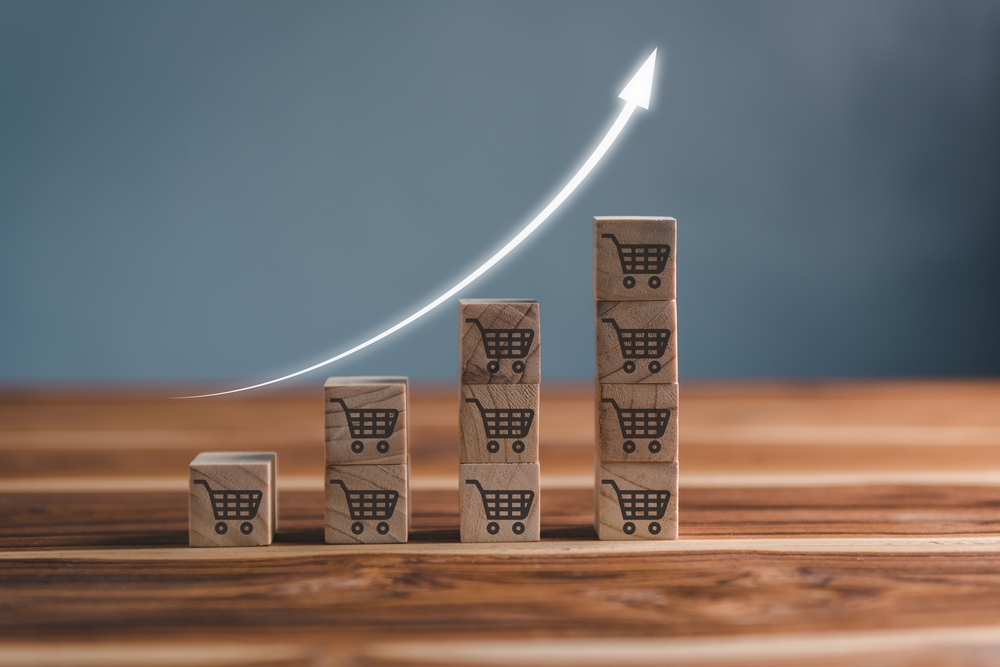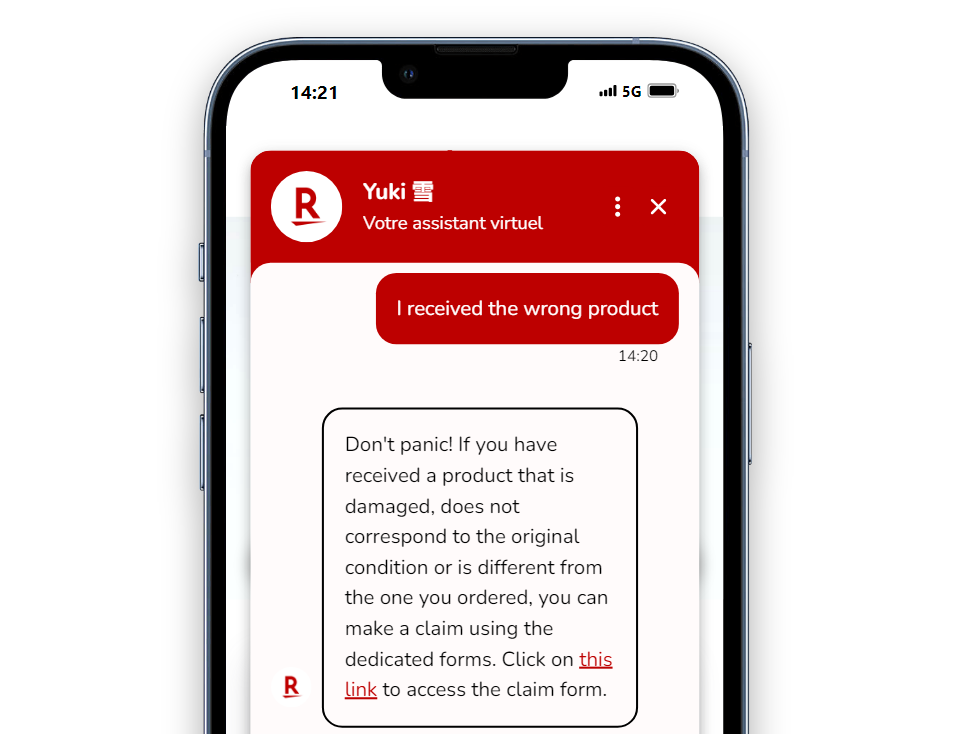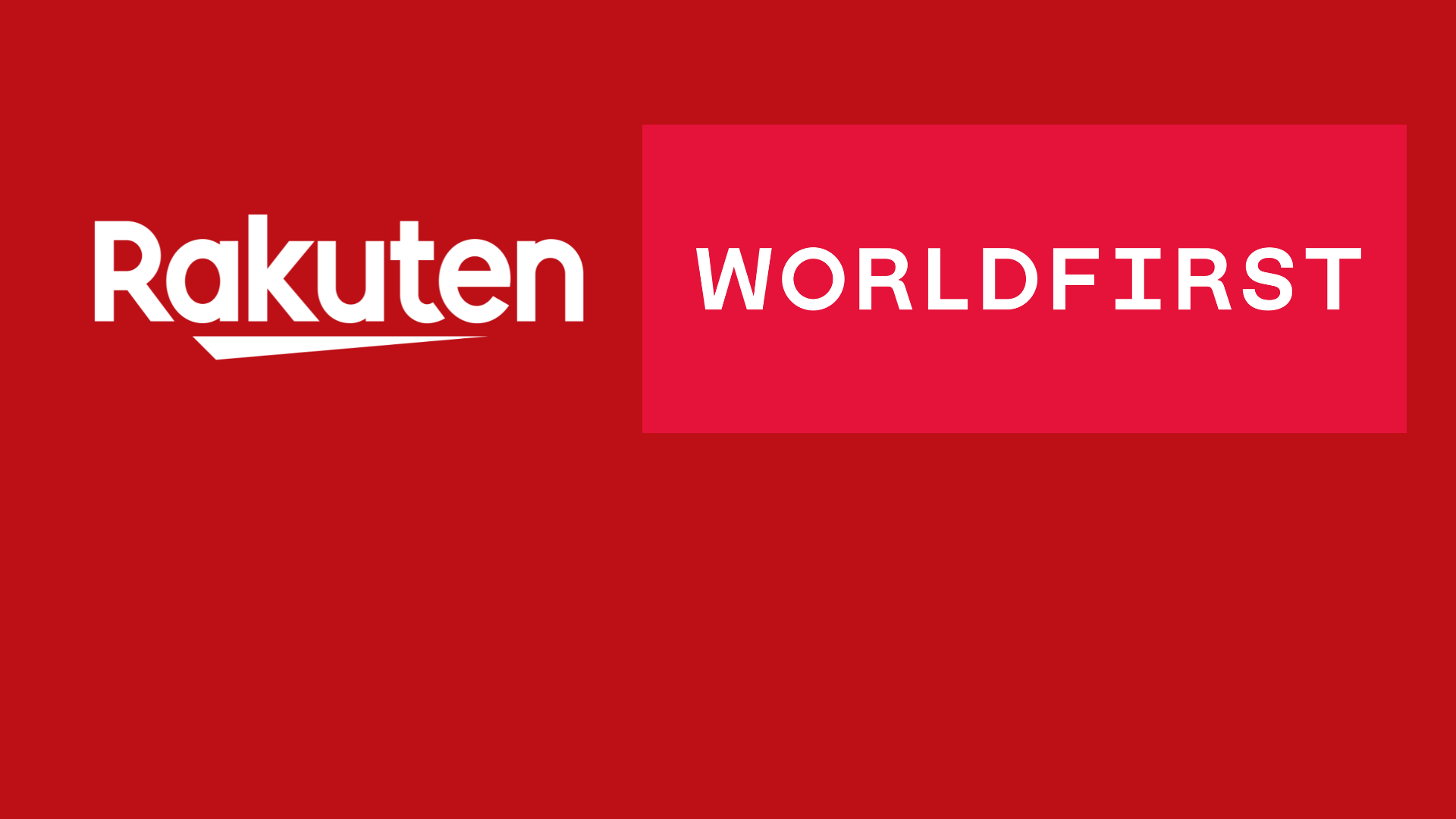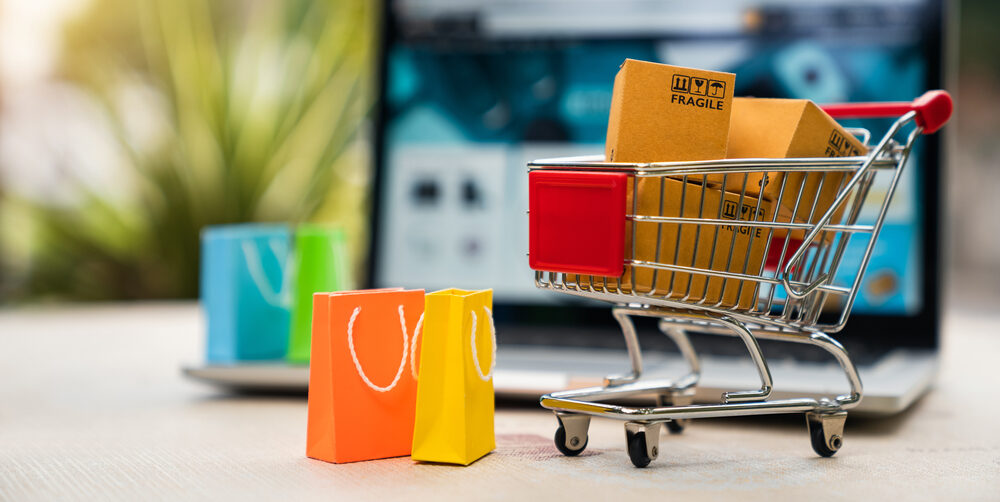Black Friday 2024: Last Key E-commerce Statistics!
Black Friday has become a must-attend event for consumers and retailers in France. Every year, the event attracts increasing interest, with sales figures rising steadily and consumers ever more eager for bargains. This year, new data sheds light on the buying habits of the French. Find out more in this article about the key figures for Black Friday 2024!
Black Friday figures
French more optimistic about their purchasing power
- 49% of French people think their purchasing power will remain stable (11 points compared to 2023), and 13% even hope for an improvement (source: Ipsos for Rakuten France).
Average budget still high
- 388€: that's the average budget per consumer expected to be spent on Black Friday this year (source: Opinionway for Bonial).
A marked interest in bargains
- 59% of French people say they are actively looking for discounts (source: Ipsos for Rakuten France).
- 96% of consumers want to be informed of these offers, and 92% of them want to be informed by digital means: e-mail, banners on websites, online catalogs, etc. (Source: Opinionway).
Increase in online purchases
- Nearly 40% of spending takes place online during Black Friday (versus 21% the rest of the year) (Source: Kantar Worldpanel).
- 42% of French people plan to make their purchases exclusively on the Internet (source: Opinionway for Bonial).
- 53% of online purchases are made from a cell phone (source: Criteo)
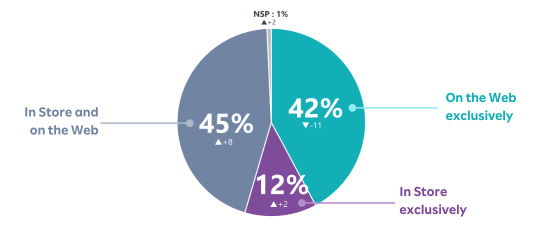
Source: Etude - Les Français et le Black Friday, Opinionway for Bonial, 2024
Shopping in anticipation of the festive season
- More than 8 out of 10 French people plan to do their Christmas shopping on Black Friday. This is particularly the case for young people aged 16 to 34. 92% of them plan to buy on Black Friday, and 46% are already used to it. (Source: Rakuten and Ipsos).
Black Friday at Rakuten
Black Friday is a key event at Rakuten. It's the perfect opportunity for our sellers to boost their sales by reaching the many visitors to the marketplace. And for our customers, it's the perfect time to take advantage of great discounts while collecting maximum cashback.
Since 2018, sales on Rakuten during Black Friday have recorded average annual growth of 7 .3%. A number driven by ever-increasing numbers of customers and an ever-more varied offering. Today, over 200 million new and used products are sold on the marketplace by our 10,000 sellers. Our 15 million monthly visitors are delighted by this wide range of products.
The average shopping basket of our Rakuten customers during Black Friday is also growing, averaging 9 .3% per year. This trend is all the more marked among the 12 million members of our loyalty program, whose average basket is 40% higher than that of non-members.
Among our many categories, Electronics (computers, tablets, smartphones, etc.) was the best performer during the last Black Friday. The Books category (literature, manga, comics, e-books, e-readers...) is in second place.
Consumer expectations for Black Friday 2024
As with previous editions, this year the French are expecting great discounts, a wide choice of products and a smooth online shopping experience. They are particularly attentive to the following elements:
- Price : consumers are looking for the best prices and discounts.
- Product quality: Consumers are looking for quality products and reliable sellers. They pay particular attention to customer reviews.
- Additional offers: immediate promotions or cashback make your products even more attractive.
- Shopping path: a fluid, relatively short shopping path limits cart abandonment and guarantees maximum sales.
- Delivery options: consumers want to be delivered as quickly as possible, and pick up their purchases easily. Consider opting for express delivery to satisfy your most hurried customers. Offering click and collect or relay point delivery can also help you stand out from the competition.
The French compare prices on various online marketplaces, use price comparators and participate in bargain forums to make sure they don't miss out on the best deals.
At Rakuten, our sellers particularly stand out with two types of promotion:
- Discount coupons: for example, €15 free for every €100 purchase or more.
- Cashback with Rakuten Points: for example, 15% back into your kitty, to be used on Rakuten.
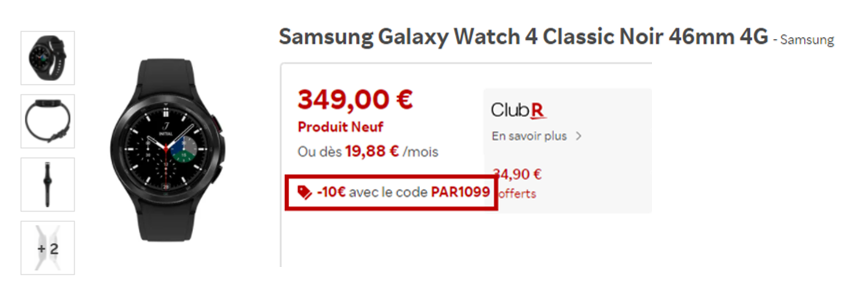
During Black Friday, these promotions can be combined to attract even more customers. If you're a Rakuten seller, talk to your E-Commerce Consultant! He'll help you set up the best promotions for your products and your strategy.
Five mistakes to avoid for a successful Black Friday
- Think sales only: keep your profits in mind. Big discounts can be a real asset, but not if they come at the expense of your margin.
- Not investing in visibility: competition is fierce during Black Friday, and it can be difficult to stand out on marketplaces. Consider investing in services that increase your visibility, such as Rakuten Ads.
- Not taking care of your ads: your product sheets are the first contact consumers have with your brand, and the reflection of the quality of your products. Make sure you take good care of them. Consult our checklist to find out more.
- Not knowing your consumers' expectations: your consumers have clear expectations for Black Friday (in terms of price, desired discounts, etc.). It's particularly important to know the specific expectations of your product category, so that you can position yourself in the best possible way.
- Poor stock anticipation: as you've seen, sales increase significantly during Black Friday. If you run out of stock prematurely, you'll miss out on many opportunities! Remember to check your stocks beforehand. Short on time? Outsource your logistics with a service like Rakuten Fulfillment Network!
2024 CHRISTMAS BAROMETER RAKUTEN FRANCE x IPSOS
THE FRENCH ARE MORE OPTIMISTIC THIS YEAR ABOUT THEIR PURCHASING POWER:
BLACK FRIDAY DEALS, CASHBACK AND GIFT RESALE (AN AVERAGE OF €100 EARNED IN 2023!)
Paris, November 14, 2024 – The French are preparing to enjoy the end-of-year celebrations in a context where every expense matters and consumer behavior is changing. Between the appeal of Black Friday sales and the increased trend towards second-hand products, the choices are becoming clear. The new 2024 Christmas Barometer, conducted by Ipsos for Rakuten among 2,500 French people aged 16 and over, reveals the shopping trends for this year-end. What is driving their choices this year? How do they feel about the coming months?
A MORE SERENE END OF YEAR: THE FRENCH OPTIMISTIC AND PREPARED FOR CHRISTMAS
This year, the French are showing renewed optimism about their purchasing power: almost half (49%) think it will remain stable (+11 points vs. 2023), and 13% even expect an improvement. This brighter perspective marks a decline in the pessimism that prevailed the previous few years: 53% thought their purchasing power would worsen in 2022, versus 50% in 2023 and 38% in 2024.
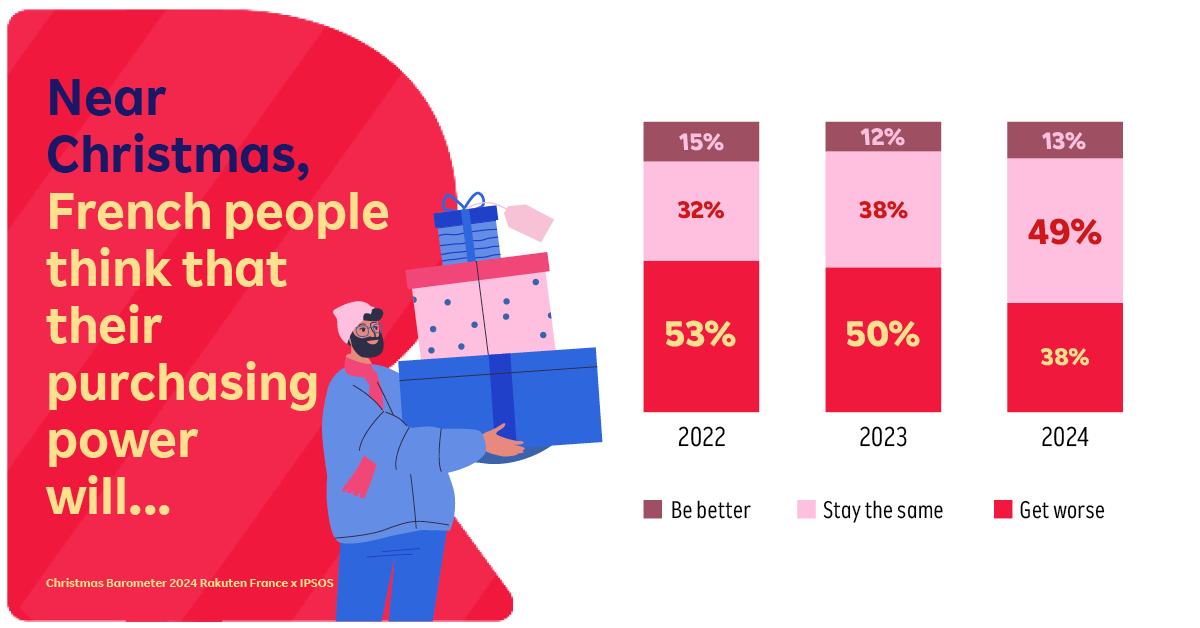
Concessions are mainly expected to affect clothing (60%), hobbies and cultural activities (55%), and household energy (42%), while high-tech products and electronics seem to be less affected this year, allowing the French to preserve certain enjoyments.
BLACK FRIDAY: THE KICK-OFF TO THE END-OF-YEAR CELEBRATIONS
The French seem to approach their end-of-year purchases more carefully. Many are planning ahead to manage their budgets as efficiently as possible: 75% say they are forward-looking, and 46% have set themselves a budget to stick to, a trend that has risen by 3 points. They are also particularly attentive to good deals, with 59% of them actively looking for discounts.
In this dynamic, Black Friday is a key moment to anticipate the celebrations by taking advantage of significant discounts while optimizing expenses.

![]()
SECOND-HAND BECOMES A HABIT TO RECONCILE BUDGET AND ENVIRONMENTAL IMPACT
For this year's celebrations, the French continue to turn to second-hand items, a smart choice that is both economical and ecological.
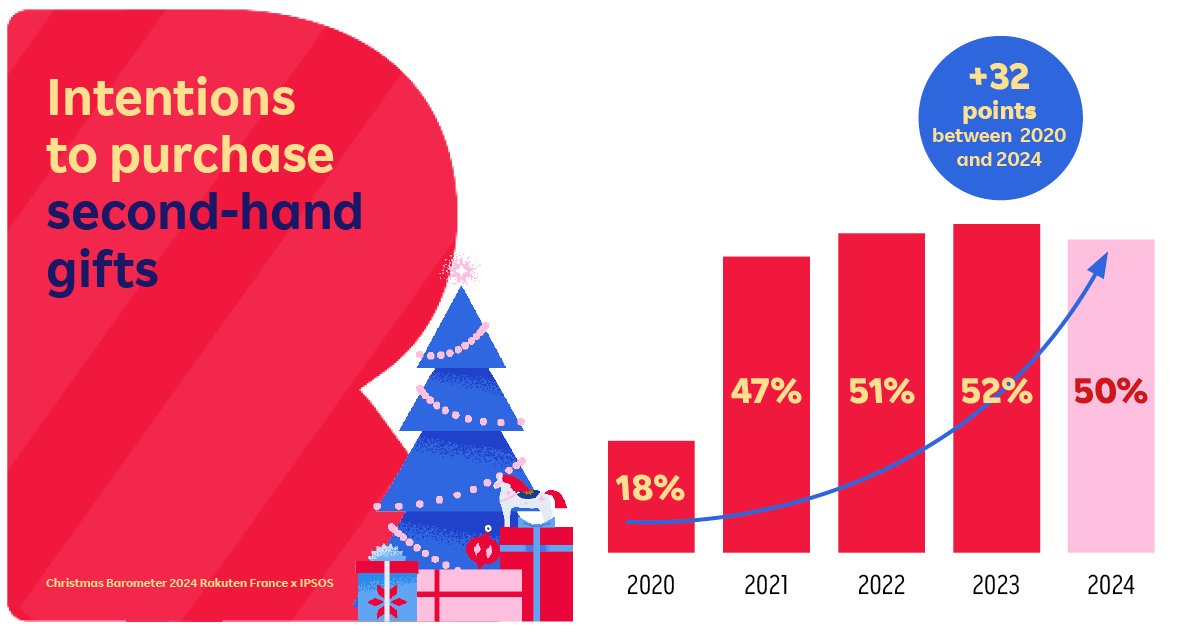
One out of two people in France (50%) plans to offer second-hand or refurbished gifts, a practice that has risen significantly since 2020[1], a sign that it is taking root in consumer habits.
Among the shopping behaviors on which they believe they have a positive impact, 32% of the French mentioned buying second-hand (+ 4 points vs. 2023).
The most popular second-hand gift categories for Christmas include cultural items (46%), clothing (41%) and toys (38%).
Cédric Dufour, CEO of Rakuten France and Rakuten TV comments: « Between 2020 and 2021, we've seen a real boom in intentions to buy second-hand gifts, a trend we believe has been amplified by the lockdowns, encouraging the French to rethink their way of consuming. Today, this interest in second-hand products is much more than a passing hype: it's a true paradigm shift.
In a context where purchasing power is under pressure, the second-hand market helps the French to reconcile the pleasure of gift-giving with prudent budget management, while contributing to a more sustainable Christmas. We at Rakuten France are proud to play a central role in this transition, by offering our users a vast choice of pre-owned and refurbished products that meet their expectations, whether economic or ecological. »
THE FRENCH INTEGRATE CASHBACK INTO THEIR LIFESTYLE TO OPTIMIZE THEIR BUDGET
The French appreciate online shopping for its many advantages. The convenience of finding products (57%), the possibility of comparing prices (56%), as well as a wide choice (53%) and flexible delivery options (50%) make it the preferred channel for buying gifts again this year.

The 2024 study conducted by Ipsos for Rakuten France on “The French and cashback” revealed in June that almost half of French people (48%) were already using a cashback program to maximize their purchasing power, confirming the growing importance of this option in consumer habits.
100 EUROS EARNED ON AVERAGE BY FRENCH PEOPLE WHO RESELL THE GIFTS THEY RECEIVE
At the end of the Christmas season, for many French people, reselling gifts is a way of recovering their purchasing power. Nearly 4 out of 10 French people say they are prepared to resell gifts that don't suit them, a practice that is becoming more and more socially accepted: 71% of French people say they wouldn't be offended if one of their gifts were resold. This trend, which combines common sense and pragmatism, not only avoids waste but also offers a real financial boost.
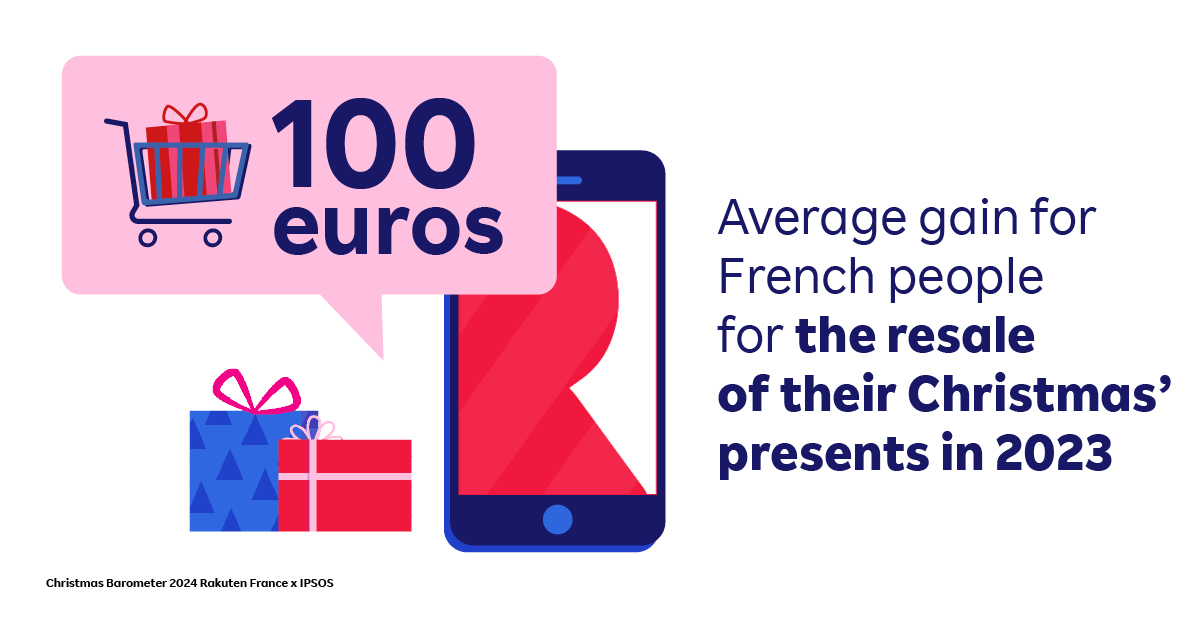 For the first time, Rakuten asked the French to estimate how much they could earn by reselling their gifts after the holidays, and the results speak for themselves.
For the first time, Rakuten asked the French to estimate how much they could earn by reselling their gifts after the holidays, and the results speak for themselves.
On average, the resale of one or more gifts allowed them to earn 100 euros in 2023, a substantial additional income at a time of strong pressure on purchasing power.
23% of resellers even generated more than 100 euros, and for 2% of them, the amount even exceeded 500 euros!
Praised for their simplicity and speed, online resale platforms such as Rakuten France allow 75% of resellers to carry out these transactions easily.
Methodology
The Rakuten - IPSOS study was based on a national sample of 2,500 individuals representative of the French population aged 16 and over. The survey was conducted online in October 2024.
- OpinionWay survey for Rakuten, 2020 ↑
Tips for a successful e-commerce packaging
In e-commerce, product packaging plays a crucial role in the customer experience, especially on marketplaces. Find out in this article how successful packaging can help boost your sales.
Packaging, a decisive element in e-commerce
More than just a container, packaging represents the first point of physical contact between your brand and your customers. According to an Ipsos study, 72% of consumers say that packaging directly influences their purchasing decision (2023).
What's more, in a context where 52% of consumers say they have already switched brands because of disappointing packaging (Source: PackagingDigest, 2023), investment in good wrapping appears to be a necessity rather than an option.
Indeed, packaging that is attractive, functional and in line with your brand image can arouse the interest of your customers and win their loyalty. Conversely, poorly thought-out or poor-quality covering can damage brand perception and your conversion rate.
The keys to successful packaging
To design effective packaging, you need to define your target audience and persona. Do you really know your customers' expectations and preferences? This will enable you to orient your design and functionality choices to create wrapping that is both visually appealing and practical to use.
Pay particular attention to the following elements:
- Visual identity and design must be consistent with your brand. In fact, 67% of consumers are influenced by packaging design when shopping in-store (Source: Nielsen Global Survey, 2023).
- The choice of materials also plays an essential role in the perception of product quality. Thick cardboard or glass wrapping may suggest a high-end product, while thin plastic may give a lower-end impression.
- What's more, practical, functional packaging significantly enhances the user experience. Think of things like ease of opening and portability.
- Finally, legible information on the packaging reassures consumers and reinforces their confidence. Make sure that essential details, such as ingredients, instructions for use and nutritional information, are clearly visible.
Make sure these elements also appear directly on your product sheets, to capture your customers' attention and convince them to buy.
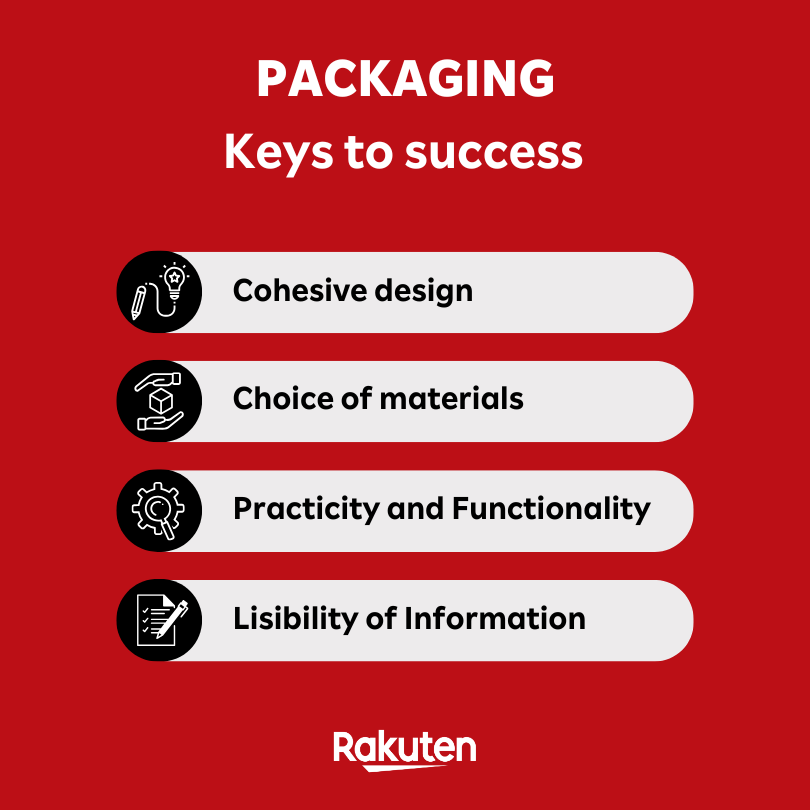
Current packaging trends
Consumers increasingly prefer recyclable and biodegradable packaging. In fact, 60-70% of consumers say they are willing to pay more for environmental-friendly package (Source: McKinsey Sustainability, 2023).
Brands that integrate recyclable materials, biodegradable packages, or reduce the use of plastic can not only attract more customers, but also strengthen their brand image.
At the same time, minimalist packaging is gaining in popularity, with clean, simple designs that convey an image of sophistication and modernity. Offering customized wrapping options, such as unique labels or special messages, helps to create a more personal connection with the customer.
What's more, integrating technologies such as QR codes can enrich the customer experience by providing additional information. More and more brands are using their packaging to tell the story of the product, from the source of the raw materials to the manufacturing process.
How does packaging influence customer loyalty?
Well-designed packaging not only attracts consumers' attention, it also plays a crucial role in building loyalty. A positive unpacking experience, marked by details such as personalized messages or free samples, can turn a simple purchase into a memorable experience.
For example, brands such as Apple and Glossier are famous for their unboxing experiences, which increase the perception of the product's value and strengthen the emotional connection with the customer.
Encouraging customers to share their unboxing experience on social networks can also increase brand visibility and help create a community of loyal customers.
Indeed, 55% of consumers are more likely to repurchase a brand after a positive unboxing experience. The recommendation rate also increases by 30% thanks to premium packaging (Source: Dotcom Distribution, 2023). Successful packing thus generates a positive domino effect, increasing customer loyalty and satisfaction.
Mistakes to avoid
To ensure that packaging has a positive impact on the customer experience, the following mistakes should be avoided:
- Over-packaging is a major concern: 78% of consumers believe that some brands use too much wrapping (Environmental Research Letters, 2023). This concern is both practical (having to remove three layers of wrapping is frustrating) and ethical (over-packaging is far from consistent with sustainable development).
- Inconsistency with the brand image can create confusion. It's crucial to maintain visual consistency with colors, logos and styles that are faithful to your brand identity.
- Complexity is another mistake to avoid. A package that is difficult to open or handle can turn a positive buying experience into a frustrating one.
- Non-compliance with environmental and safety standards should also be avoided. Using non-recyclable or polluting materials, or failing to comply with compliance rules, can seriously damage your brand image. It can also expose you to legal risks. On Rakuten, for example, safety instructions must be indicated on your productwrapping (age requirements, instructions for use, etc.).
By avoiding these mistakes, you can ensure that your packaging attracts and retains customers, while reinforcing your brand image.
Ads in E-Commerce: How to Boost Sales during Black Friday
Black Friday has become a must-attend event for e-tailers. It represents a unique opportunity to boost sales and revenues. However, in an increasingly competitive online environment, it can be difficult for e-tailers to stand out from the crowd.
Whether you have an e-commerce site or sell through a marketplace, find out how simple and effective Ads formats can help you capture your customers' attention and maximize your sales during this key period.
The importance of being visible during Black Friday
In 2023, 72% of consumers chose to shop online for Black Friday (Salesforce, 2024). As the number of e-buyers continues to grow, there's no shortage of choice when it comes to e-commerce sites and marketplaces to turn to. The Fevad lists 152,000 active e-commerce sites in France, and the number is growing by around 10% every year.
Online visibility is therefore a crucial factor in standing out from the crowd and boosting sales. Implementing innovative advertising strategies is an excellent way of achieving this.
Three types of Ads to boost sales during Black Friday
Discover below three types of advertising you can use to capture the attention of your potential customers and convert them.
Countdown banners: create urgency
There's nothing like a countdown to trigger action! By displaying the time remaining for your coupons and promotions, countdown banners create a sense of urgency that drives users to make quick decisions. These banners are particularly effective because they exploit a powerful psychological lever: the fear of missing an opportunity.
To maximize their impact, it's essential to opt for an attractive design and a clear message. Use bright colors and powerful phrases such as "Last chance!" or "Don't miss out!

Don't hesitate to use the countdown format on your various communication channels: banners on your e-commerce or e-shop site, social networks, e-mails..
And make sure your banners are optimized for mobile devices. Indeed, 62% of French e-buyers make their purchases via their smartphones (source: Fevad).
Behind-the-Scenes format: Connecting with your audience
The Behind-the-Scenes format gives an authentic insight into your business, building trust and engagement. Share content showing the preparations for your Black Friday, for example. Think in particular about using short videos or stories on your social networks, to maximize the impact of this ad format.
The objective? Make a lasting impression by revealing the behind-the-scenes aspects of your business and demonstrating your know-how. Don't hesitate to adopt a personal tone and add a touch of humor to make your videos captivating!
This "inside" content humanizes your brand and creates an emotional connection with your audience. A good thing for both your brand image and your conversions. A Social Media Today study showed that this type of publication generates a 50% higher rate of engagement than traditional content.
Retargeting: boost your conversions
Retargeting involves targeting prospects who have already interacted with your store. Whether they've already added your products to their shopping cart or simply visited your e-commerce site, you can recontact them with personalized advertising and targeted offers. According to Google, it takes an average of 8 contact points to generate a conversion. A targeted, personalized follow-up is therefore essential to maximize your chances of converting these customers.
Using browsing data and purchase behavior data, you can deliver personalized ads to remind these visitors of the products they have viewed or added to their shopping cart.
At Rakuten, for example, our teams draw on their technical expertise to deliver retargeting actions that are as targeted and effective as possible. Our customers receive personalized reminder e-mails and push notifications when they have not finalized an order.

This strategy is particularly effective for customers who have abandoned their shopping carts. It keeps them interested, encourages them to return to your e-commerce site or e-shop and finalize their purchase.
Use eye-catching visuals and simple messages along the way. And don't forget to distribute these reminder ads across several channels: display, social networks, personalized e-mailing..
And on Rakuten? Our Ads to put your products in first position
Over 200 million products are sold on Rakuten by our 12,000 professional and numerous private sellers. So it can be hard to stand out from the crowd.
It was with this in mind that we developed our marketplace-integrated advertising solution, Rakuten Ads. This service enables your items to be positioned on certain keywords and thus to move up on search pages and product sheets.
Rakuten Ads are based on a cost-per-click system, meaning you only pay when a customer clicks on your ad. You can monitor the performance of your campaigns directly from your dashboard: impressions, clicks, conversions... all the indicators you need to adjust your strategy.
How can you increase your visibility on a marketplace?
In the world of e-commerce, marketplaces have become indispensable, offering sellers considerable visibility and audience reach. However, with thousands of competing sellers, it’s essential to stand out and increase your visibility to attract the attention of potential buyers.
Whether you’re an established seller looking to improve your performance or a newcomer to the market, these tips will help you increase your presence and generate more sales. However, they also raise a pertinent question for businesses : the choice between a marketplace presence and an independent online business.
Why is it so important to be visible on marketplaces?
1/ Increased sales opportunities
Increased visibility means more potential buyers will have access to your products. The more visible your product is, the more likely it is to be considered and purchased by customers. This opens up new sales opportunities and enables you to reach a wider audience.
2/ Credibility and trust
High visibility on a marketplace boosts your brand’s credibility and inspires confidence in buyers. When they see your products appear regularly in search results and popular category pages, customers tend to regard you as a reliable and worthy seller.
3/ Access to a wider audience
Marketplaces offer an already large and established audience. By increasing your visibility, you can reach potential customers you wouldn’t otherwise have access to. This enables you to extend your reach and reach specific geographic markets or customer segments.
4/ Competitive advantage
In a competitive environment, good visibility enables you to stand out and outperform your rivals. By being more easily found by buyers, you increase your chances of generating sales and gaining market share over other sellers present on the marketplace.
5/ Feedback and brand awareness
Increased visibility can also mean more feedback and ratings from your customers. These positive reviews help build the confidence of future buyers and enhance your online reputation. A good reputation on a marketplace can help you attract new customers and retain existing ones
How can you optimize your store’s presence on marketplaces?
1/ Create an attractive profile:
Start by creating a complete and attractive store profile. Use quality images, a clear and concrete description of your business and highlight your strengths and competitive advantages. A professional, attractive profile inspires confidence and encourages buyers to explore your store further.
On Rakuten, for example, you can create an E-boutique: a space entirely dedicated to your offers, allowing visitors to discover the world of your brand. From customized banners and the organization of your shop window to the highlighting of offers and products according to the year’s highlights, you’re in control of your brand.
2/ Efficient inventory management:
Keep your inventory up-to-date and accurate. Keep an eye on stock levels, update available quantities and remove products that are no longer available. In this way, you’ll avoid disappointing your customers and maintain a solid reputation as a reliable seller.
3/ Offer quality customer service:
Responsive, quality customer service is essential to building customer loyalty and generating positive referrals. Respond quickly to customer questions and requests, handle returns and refunds professionally, and resolve problems quickly. Good customer service strengthens your reputation and encourages customers to return to you for future purchases.
Find out how to build buyer loyalty through good customer service.
4/ Take care of your product sheets
See below ↓
Our 5 tips to improve your product’s SEO and increase its visibility
Improving the SEO of your products is one of our 7 tips for selling better on marketplaces.
To optimize your product listings, you need to :
1/ Conduct keyword research:
Identify relevant keywords for your products using keyword research tools. Select popular and specific terms that are often used by buyers in their searches. Integrate these keywords naturally into your product titles, descriptions and tags.
2/ Optimize your product titles:
Product titles are essential for SEO. Use clear, concise and descriptive titles that include your target keywords. Highlight the unique features of your products and avoid generic titles. Be sure to comply with marketplace guidelines in terms of title length and format
3/ Write detailed descriptions:
Product descriptions should be informative, detailed and convincing. Describe the product’s main features, benefits and possible uses. Use short paragraphs, bullets and well-structured sections to facilitate reading.
4/ Add quality images:
Images play a crucial role in customers’ purchasing decisions. Use high-quality images that highlight the important features and details of your products. Opt for multiple angles, close-up views and situational images to give buyers a better idea of the product.
5/ Use tags and attributes:
Tags and attributes are additional information you can add to your products to make them easier to find in search results. Use appropriate tags to describe specific attributes of your products, such as color, size, material, and so on. This allows buyers to filter search results according to their preferences.
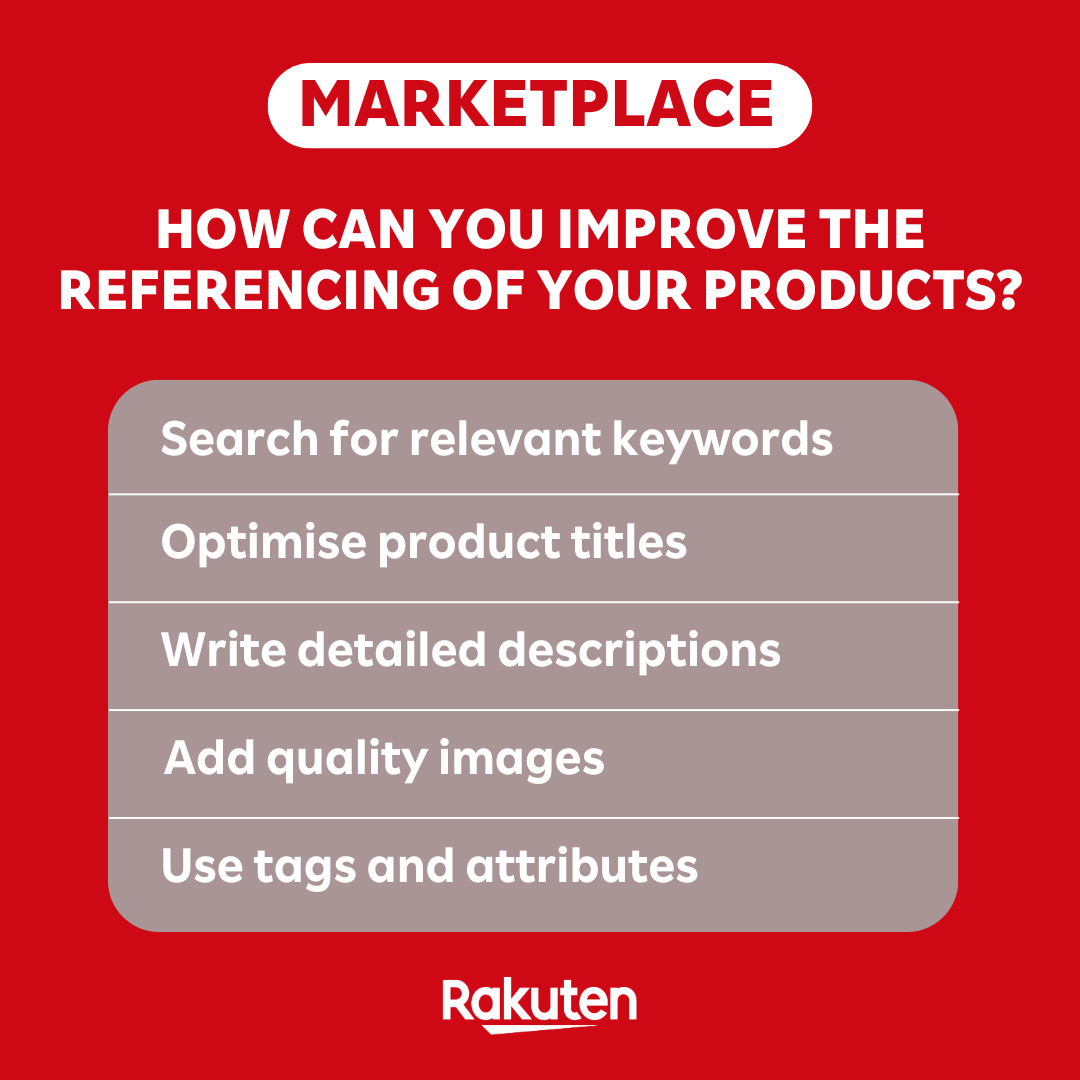
Use marketlace promotional tools for greater visibility
On most marketplaces, you’ll find several ways to promote your products:
1/ Sponsored ads:
Sponsored ads are an effective way of increasing the visibility of your products by placing them at the top of search results. You can choose the keywords on which you want your ads to appear and set a budget for your advertising campaigns. Make sure you select relevant keywords and optimize the content of your ads to achieve a good return on investment.
At Rakuten, we offer a tool, Rakuten ADS, to maximize the prominence of your ads in 1st position thanks to an algorithm that suggests products at the most propitious moments in the customer journey. If a potential buyer types in a predefined keyword, your product appears first in the search results. You can set up a cost-per-click configuration, allowing you to define a daily budget!
2/ Special offers and discounts :
Marketplaces often offer options for creating special offers and applying discounts to your products. You can create temporary promotional offers, such as group discounts, seasonal promotions or discounts for new customers. These special offers can attract buyers’ attention and encourage them to buy your products rather than those of your competitors.
With Rakuten Coupons, you can set a minimum purchase amount at which customers can use a discount coupon. On Rakuten, offers with coupons are relayed and visible on our Rakuten Deals page, one of the most frequented pages on our site.
3/ Loyalty programs and benefits :
Some marketplaces offer loyalty programs or benefits to salespeople who reach certain sales or customer satisfaction targets. These programs may give you access to additional features, special highlights on the site or reduced rates on selling fees. Make sure you explore these options and actively participate in programs that match your business objectives.
On Rakuten, there are Rakuten points that allow you to offer discounts in points to set yourself apart from the competition and build customer loyalty. Our loyalty program, Club R, is the most generous in France, with 12 million members. Club members earn points with every purchase and can redeem them on their next purchase thanks to our cashback system on all platforms in our ecosystem
Analyze and adjust your visibility strategy
It's essential to regularly analyze your performance and make any necessary adjustments.
1/ Monitor key performance indicators (KPIs)
Identify the KPIs relevant to e-commerce to assess the effectiveness of your visibility strategy. These can include the number of visits to your store, conversion rates, sales generated, which products are selling well and which aren't, customer feedback and ratings, etc.
2/ Readjust your strategy
Adjust your visibility strategy. This may involve reviewing your product descriptions, optimizing your keywords, improving the quality of your images, adjusting your advertising campaigns or exploring new marketing channels. Be ready to experiment and iterate according to the results.
3/ Keep an eye on the competition
Keep an eye on what your competitors are doing in the marketplace. Analyze their visibility strategies, their promotional offers, their presence on social networks and so on. This will help you stay competitive and identify new opportunities to stand out from the crowd.
4/ Follow market trends
The e-commerce and marketplace environment is rapidly evolving. Keep abreast of new features, market trends, algorithm changes and best practices.
5/ Join Rakuten France to be accompanied by an E-Commerce Consultant and increase your visibility
At Rakuten, our aim is to help you grow. That's why every seller on Rakuten is accompanied by an E-Commerce Consultant, specialized in your product category, who will help you optimize your presence and win sales on our marketplace.
E-commerce Website Cost: how much should you budget?
The e-commerce sector is doing well. In 2023, total sales generated by French e-tailers reached 159.9 billion euros (source: Statistica, 2024). This represents significant growth of 10.5% compared with 2022.
Faced with these positive figures and all the success stories in France, launching an e-commerce business is often idealized. Yes, it's an exciting adventure, and online visibility is more important than ever. But no, getting started in this ecosystem isn't always easy. Especially when you don't know how much to invest to get started in e-commerce.
In fact, do you know how much it really costs to create an e-commerce site? Do you have a clear idea of the budget involved? What's the most strategic financial choice between e-commerce and marketplace? Rakuten France answers all your questions: follow the guide!
E-commerce site: what criteria determine the cost of creation?
It's difficult to determine the exact cost of a website, especially in the world of e-commerce. There are many factors that can make or break the price. But before we get into the details, here's an initial minimum estimate, according to Nicolas Thomas (director of web agency MangoLight):
- The price of a basic website (or showcase) is at least €900.
- The price of a basic e-commerce site is at least €4,000.
- The price of an online platform is at least €10,000.
These figures represent the average initial cost of a digital start-up. However, don't forget all the other essential elements that go into calculating the final price of your website.
The price of an online sales site essentially depends on :
- The solution chosen
- The professionals involved
- Technical specifications
- Security services
- Maintenance and upgrades
Let's take a look at the cost of all these criteria, essential for creating a high-performance online store.
The chosen solution
The design and development of e-commerce site pages can represent a significant initial investment. First of all, you need to make a decisive choice: should you opt for a SaaS solution (Shopify, Wix, etc.) or an Open Source CMS (Prestashop, Woocomerce, etc.)?
With SaaS software, monthly subscriptions range from €20 to €50, with a commission on sales.
With Open-Source, hosting, configuration of extensions and labor (freelance or agency) are much more expensive. The budget for this type of CMS solution can range from €2,000 to €200,000.
Take Webalia, for example, which calculates the cost of an e-commerce site with 20 to 50 products. With a CMS, you can use an existing template or create a custom design. The budget required to use a template varies between €4,000 and €15,000, depending on the platform's quote. In comparison, the investment for a custom website ranges from €6,000 to €35,000. Customization comes with a cost, especially if you want a professional, high-quality website!
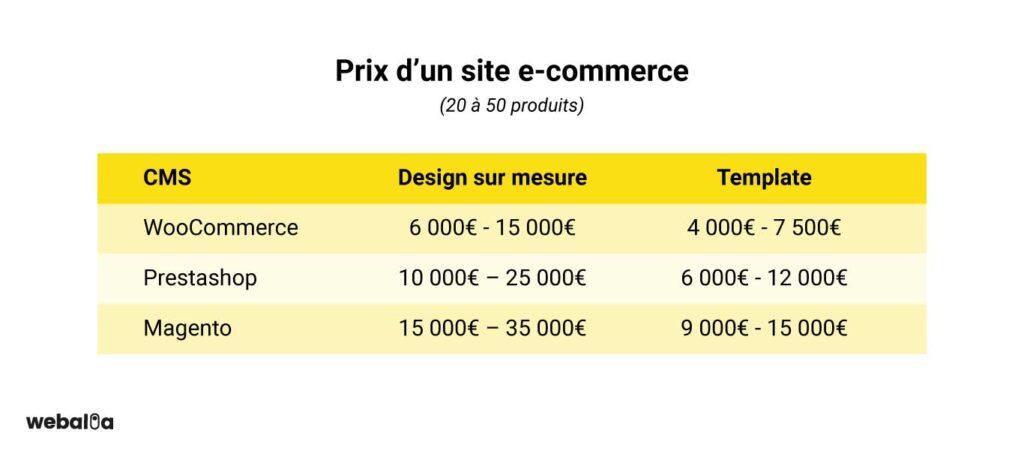
The professionals involved
Who are you going to call on to develop your e-commerce site? You have several options. Obviously, you can bring this type of project in-house, by creating the website pages yourself. Think carefully about this decision, and allocate your efforts and energy to the right place, according to your skills.
You can also hire a web developer to support you in this adventure. The median salary for an e-business developer in France is around €45,000 per year. However, developers' salary expectations are generally higher. If you add up the employer's contributions (around 30% of gross salary), the cost of an employee can quickly become out of reach for an e-commerce start-up.
The two other most common solutions are :
- Hire a freelancer to design the e-commerce site. An external service provider costs between €2,000 and €20,000 for this type of website creation project.
- Use a specialized agency (Wordpress, Magento, Wix, etc.). More expensive, agencies range from €4,000 to €50,000, depending on the scope of the project and the services included (maintenance, design, etc.).
Technical specifications
Among the technical specifications to factor into your budget are the following:
- The purchase of a domain name: this varies from around €10 to €50 per year . You may need to reserve several domain names (.fr and .com) to limit the risk of plagiarism. Have you budgeted for this?
- Website hosting: this costs between €100 and €500 per year. It varies according to the traffic you generate, the specificity of your website and your performance requirements.
- Customized functionalities: advanced payment options, intelligent search, automatic relaunch of abandoned shopping baskets, chatbot, inventory management, extension purchases... All these additional functionalities require a budget that can range from €1,000 to €10,000 per year.
To discover all the options available to you in this sector, read our guide to e-retail and its specific features.
Security services
Buyer security must be your priority... right from the website design stage! In France, 85% of Internet users believe that security is important when choosing a website. So do your utmost to offer a 100% secure online experience.
This security involves the purchase of an SSL certificate, guaranteeing secure data transfer. It costs between €50 and €200 per year. At the same time, regularly scan your website for vulnerabilities, protect it in real time (WAF, IDS/IPS) and host your content in a certified environment (PCI DSS, HADS, ISO...).
These precautions represent an investment in time and money, which is absolutely necessary to protect your customers. When you consider that, worldwide, almost one merchant in two (46%) has already been the victim of a cyber-attack since launching their business (source: PrestaShop Million Club study, 2022)... Investing in enhanced security is a priority!
Maintenance and updates
Are you planning an e-commerce site? Don't just budget for its creation! Throughout the year, you'll need to invest in the maintenance and updating of your website pages. This is essential to ensure the website's stability.
Depending on the size and complexity of your online store, you should plan on an annual budget of around €500 to €2,000. Your freelance service provider or specialized agency can make corrections and add new functionalities, according to your needs.
In addition to the cost of creating and maintaining an online store, there are other expenses to consider. Like logistics costs. According to a study conducted by Supply Chain 24/7, the average logistics cost for a company is estimated at 11%. This estimate increases every year, due to investments aimed at reducing delivery times.
More than 50% of logistics costs are allocated to managing delivery, to satisfy consumers who are increasingly focused on immediacy. The rest is shared between goods storage, order preparation, after-sales service and insurance.
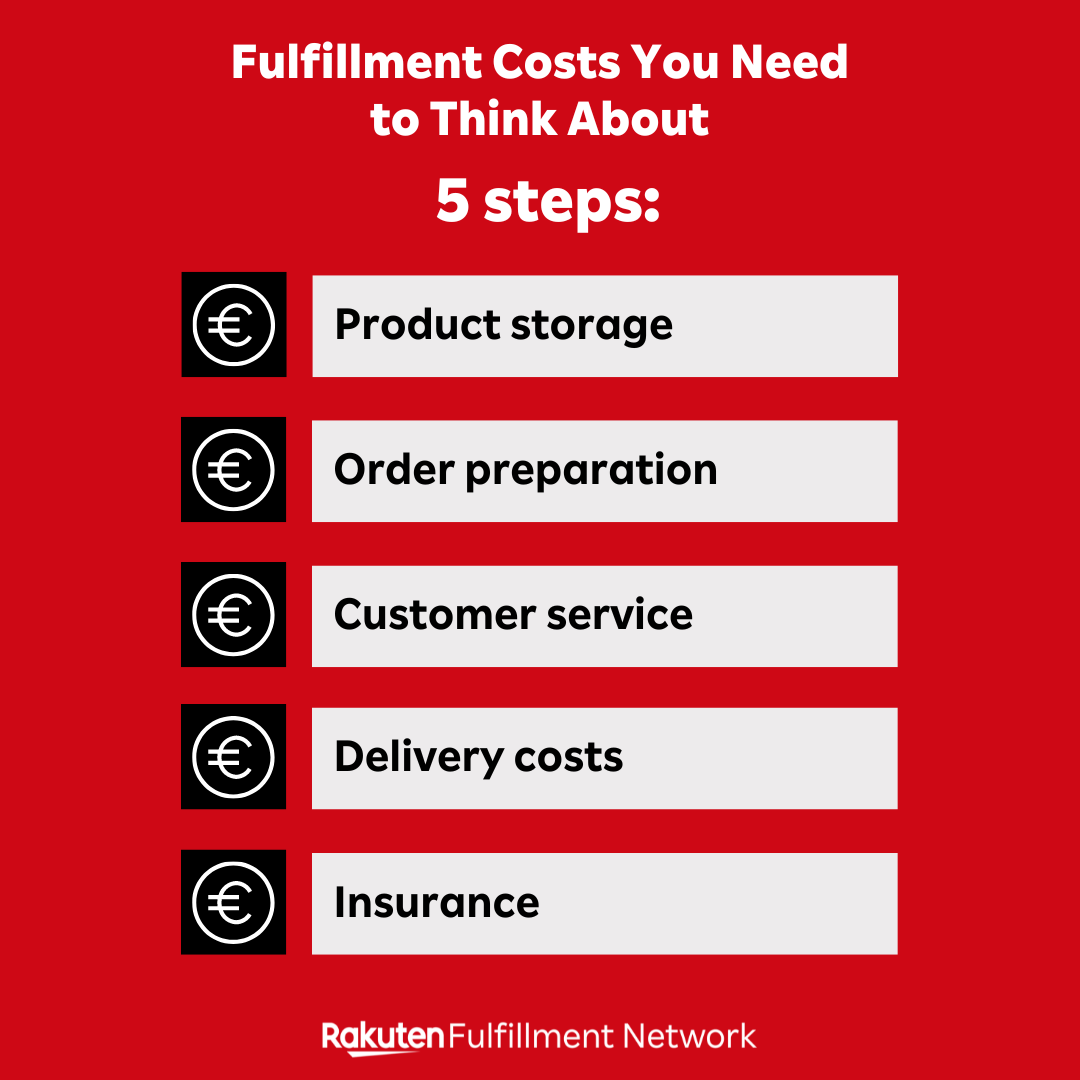
As you can see, launching an online store is an expensive project. So, to save money while selling your products, is the best option to join an existing marketplace?
Marketplace vs. e-commerce site: which is the more strategic choice?
Online commerce is a highly competitive arena. When joining it, entrepreneurs are faced with a crucial choice: is it wiser to create their own online sales site, or opt for an established marketplace?
At Rakuten France, we say it loud and clear: combining an e-commerce site with marketplace sales is completely compatible! However, when your budget isn't unlimited, choosing a marketplace can be a winning strategy. Ready to find out why?
Marketplace: instant visibility
One of the reasons many entrepreneurs choose to join an existing marketplace is the instant visibility it offers. By being present on well-established platforms like Rakuten France, exposure is immediate. The consumer audience is already active, and trust has already been established.
No need to build a customer community from scratch, spending hundreds of euros on marketing and digital acquisition campaigns... At Rakuten France, over 12 million members are ready to discover your products, directly from our marketplace.
Increased trust
Marketplaces often benefit from the trust already built up among consumers. Customers are therefore more inclined to buy on a well-known and recognized platform, where they feel secure. This feeling of security is very real: the payment stage in particular is simplified and extremely well regulated. You don't have to worry about it. Neither does the customer.
Simplified marketplace management
Managing an e-commerce site can be complex, involving tasks such as technical maintenance, updates, payment management... By joining a marketplace, these aspects are often taken care of by the platform itself.
For example, with Rakuten Fulfillment Network, you delegate packaging, delivery and order tracking. You also don't have to manage the design of product sheets, or the back-and-forth with freelancers or agencies to add website functionalities, install extensions... Your priority? Concentrate on the tasks that add the most value to your business, boosting your growth and satisfying your end customers.
Savings from A to Z
Creating and maintaining an e-commerce site involves significant up-front costs, such as development, hosting and security. In comparison, most marketplaces offer listing fees and commissions on sales, often more affordable than the initial costs associated with an independent website. At Rakuten France, we also offer free services such as sales support.
So you save money from A to Z when you join a marketplace like Rakuten France. Rather than spending tens of thousands of euros on creating and managing an e-commerce site, joining a marketplace is a more economical project... And often more profitable! Did you know that in 2020, marketplaces grew by 81%, twice as fast as e-commerce? (source: Mirakl, 2021)
To discover our affordable rates, and benefit from 12 million loyal buyers... Go here!
Customer reviews and e-commerce: collecting, managing and distributing feedback
58% of French people say they consult customer reviews before making an e-commerce, marketplace or in-store purchase. Among 15-24 year-olds, 70% of buyers are even sensitive to online feedback (source: Toluna Harris Interactive for Fevad).
For Internet users, the presence of ratings and stars is now essential before making a purchasing decision. And for e-commerce sellers, these reviews have a considerable impact on product reliability, brand credibility and sales growth.
So how to best manage customer reviews in e-commerce? How can you collect, moderate and disseminate these reviews effectively, so as to benefit from positive spin-offs for your online store? Discover Rakuten's advice and the mistakes to avoid, to earn those (5) stars.
Customer reviews and e-commerce: how important are they?
How can you do without online reviews? Today, it's impossible. From star ratings to detailed comments, customer reviews are part of every buyer's shopping experience. Before making a purchasing decision, to compare several products or to ensure the reliability of an e-commerce site or marketplace seller, Internet users consult the feedback of their peers.
According to an IFOP study for Guest Suites (2023), 92% of French people no longer buy anything without consulting customer reviews. The priority for salespeople is therefore to collect, manage and disseminate these precious elements of customer satisfaction. And if you're still hesitating to do the same, here are the main benefits of customer reviews:
Increase buyer confidence
The presence of online reviews increases buyer confidence and reassurance. Even if the company or product you're looking for doesn't only have positive reviews. According to IFOP, 68% of customers don't trust an establishment with only positive reviews.
To win the trust of Internet users, it's essential to collect feedback. If some of them are negative, it doesn't have to be that way: respond to them publicly with kindness and empathy, apologize and get in direct contact with the buyer... So that they'll give you a "second chance to make a good first impression"!
Strengthen customer knowledge and continuous improvement
Whether it's product, brand or experience feedback (delivery, after-sales service, etc.), every customer feedback is a gold mine of information. By analyzing it, you can identify areas for improvement, complaint criteria and your own strengths. You improve customer knowledge, and take advantage of it to continuously improve your offers and the shopping experience.
Our advice? Create a ritual of analyzing customer reviews, at least once a month. Give priority to recurring remarks. For example, if delivery times are regularly criticized, take immediate action with your carrier. Conversely, if your product is regularly praised (for its comfort, ease of use, design, etc.), make sure you use these elements in your product sheets!
Improve sales and conversion rates
The presence of customer reviews on a product page (in e-commerce or marketplace) is a real growth driver: these ratings improve the sales and conversion rate of online stores. The presence of numerous positive customer reviews also helps reduce shopping cart abandonment.
Without these elements of social proof, it's difficult to attract consumers, reassure them and convince them. Conversely, the more reviews a brand and its products have, the greater the chances of a sale. All the more so if those reviews are positive!
According to McKinsey, online products with ratings between 3 and 4 stars (out of 5) achieve sales three times higher than products with only one star. The more positive the rating, the greater the impact on sales.
However, as we have seen, the collection of neutral or negative reviews is not fatal to growth. According to a Reevo study, the conversion rate increases by 67% in the presence of a negative review, if the seller responds and provides a solution.
Strengthen natural search engine optimization (SEO) and e-reputation
In addition to improving consumers' web experience, conversion rate, trust and customer knowledge, e-commerce reviews have a direct impact on SEO and e-reputation. Indeed, post-purchase reviews are natural referencing criteria taken into account by search engines such as Google.
These reviews are user-generated content that enhances the information and content already present on an e-commerce site or marketplace product sheet. They complement the "Rich Snippets" (link descriptions on search pages like Google), by directly displaying the rating and stars. The number of reviews, their recency and their positivity all contribute to increasing the visibility of e-tailers on search engines.
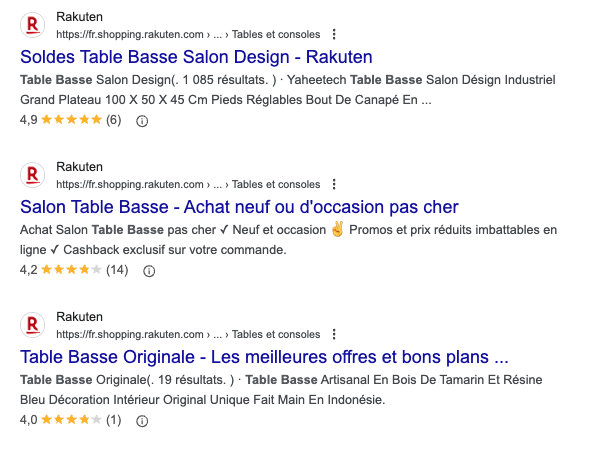
How do you collect, manage and distribute customer reviews?
Whether you run your own e-commerce site or sell through a marketplace, customer reviews are an essential metric. They showcase the quality of your services, and are an indispensable source of information for consumers. But before you can take advantage of their many positive impacts, you need to go through three stages: collecting, managing and distributing these online reviews.
1- Collecting user reviews
Collecting customer reviews is an essential step. To maximize your chances of obtaining post-purchase feedback, you can encourage customers to leave a web review. In fact, solicited reviews (as opposed to unsolicited reviews) are considered to be the best way to collect higher ratings: 4.34/5 on average for solicited reviews, compared with 3.89/5 for unsolicited reviews (source: ReviewTracker).
To solicit customer feedback on your e-commerce site or marketplace, you can :
- Integrate the review request directly into the shopping experience: for example, with a message displayed after checkout, to share feedback on the shopping experience.
- Send a request by e-mail or SMS just after the order has been delivered: ideal for obtaining feedback on the product(s) purchased.
- Send a satisfaction questionnaire 7 days after delivery, to gather overall feedback on the purchasing experience and product use.
To encourage consumers to leave a review (and boost the number of comments), you can also offer them a reward. At Rakuten, we offer cashback in the form of Rakuten Points to every customer who leaves a review on an order or a seller. The customer can then use this amount for future purchases on the platform. It's a simple way of boosting the number of reviews by offering buyers an attractive return. A win-win situation!

2- Manage, qualify and respond to customer reviews
After collecting customer reviews, the next step is to manage them. First of all, we would like to remind you that it is forbidden to delete reviews you don't like, unless they contain abusive or violent language, illegal content or are unreliable and linked to proof of purchase.
It's essential to analyze both positive and negative reviews: once collected, you'll be able to identify the main reasons for customer satisfaction and dissatisfaction, and better understand any glitches or nuggets.
For a low volume of comments, you can manage this analysis manually. For larger volumes, you can automate the qualification process, using Sentiment Analysis tools for example. These tools enable you to identify the intent of a review, by pinpointing recurring keywords, so you can continually improve the buying experience and the products offered for sale.
After this analysis and qualification phase, you must then respond to all the reviews you receive. Respond to them every day, so you can offer quick, responsive answers to web users. Keep your messages short, effective and friendly:
- Start by thanking the buyer for their review, whether positive or negative.
- In the case of positive feedback, create an additional positive interaction: for example, by openly telling them that their opinion means a lot to you, and that you hope they'll enjoy the products they've purchased.
- In the case of a negative review, offer a professional, solution-oriented response: for example, offer the buyer a refund, exchange or voucher. Always apologize for the unfortunate experience, and invite the consumer to continue the exchange live and in private.
To take customer relations even further, here's a bonus: activate the "Questions/Answers" feature on your Rakuten store. In addition to the reviews on a product page, Internet users can read questions from their peers, and the seller's answers. This tool provides valuable additional information, useful for boosting marketplace sales!

3- Optimize your distribution of customer reviews
Once collected and managed, the final step for your company is to distribute the reviews online. Obviously, product reviews have their place on the relevant product pages. But you can also relay the feedback you receive at different points on your e-commerce site (right from the home page).
And don't forget to highlight good reviews via your marketing and communication channels: e-mailing, social networks, SEA ads... Optimizing the distribution of these social proof elements will strengthen your credibility!
Customer reviews: 5 mistakes to avoid on your e-commerce site or marketplace
You now have all the tools you need to collect, manage and distribute customer reviews... But beware of these 5 mistakes, which can damage the shopping experience and your company's image:
1- Not soliciting reviews
As we saw in this article, solicited reviews are very popular, and provide better feedback than unsolicited reviews. 39% of French people even say they are encouraged to leave a post-purchase review when a brand sends them an e-mail (source: YouGov, 2022). Now you know what you have to do..
And remember, with Rakuten, your customers get cashback in exchange for their feedback!
2- Don't respond to reviews (or respond badly)
Failing to respond to reviews can damage your brand image and e-reputation. Internet users are sensitive to the commitment and consideration shown by sellers on e-commerce sites and platforms: so take the time to respond to all feedback received, whether positive or negative!
When drafting your responses, be sure to personalize your messages. Generic or automated responses should be avoided at all costs. Instead, write a unique response, mentioning the customer's name and thanking him or her personally.
3- Publish fake web reviews
The legal framework surrounding customer reviews is strict: be careful not to break the law! For example, you don't have the right to delete negative reviews that you don't like, in order to publish only positive reviews, and thus artificially boost your online reputation. You're not allowed to publish fake reviews either: that would lead to legal sanctions. Worse still, such actions destroy buyer confidence.
4- Failing to improve service after responding
Imagine a dissatisfied customer to whom you reply: "We're aware of the problem. We'll take care of everything" ... Without ever taking any action to actually deal with the problem.
The customer remains dissatisfied, and you lose any chance of making up for the bad experience. To avoid this scenario, here's our advice: with every review you receive, demonstrate continuous improvement, at every level of the buying journey (payment experience, delivery, product quality, customer service, etc.). Then provide concrete evidence to dissatisfied users, to show that you're taking their word into consideration.
5- Not valuing web reviews
Every positive review you receive is a golden opportunity to promote your brand and your products: when implementing your marketing strategy, always integrate the dissemination of user feedback across your various channels.
Newsletters and e-mails, SEO and SEA ads, publications on social networks... Your online reviews can also be useful for boosting your sales, during the major commercial holidays. To find out when to use brand and product reviews effectively, check out our calendar of e-commerce highlights.
Apple Keynote: announcements boost the second-hand market
Paris, September 18 - Every year, the Apple keynote attracts worldwide interest, not only for the release of new products, but also for the buying and reselling opportunities it generates on the market. As a major player in e-commerce, Rakuten is closely observing these trends. The company notes a veritable phenomenon of resale and purchase of new and second-hand products that accompanies this major event. An analysis of the data shows that the keynote is not only a highlight for tech enthusiasts, but also a financial opportunity for savvy consumers.
APPLE KEYNOTE BOOSTS IPHONE SALES ON RAKUTEN
The keynote's impact on iPhone sales is indisputable. Every year, the announcement of new models sparks renewed interest in previous generations on the platform.
- In 2022, iPhone sales on Rakuten jumped by 59% in the 30 days following the keynote. Some models particularly benefited from this wave, such as the Alpine Green iPhone 13 Pro Max, whose sales exploded by 623%.
- In 2023, although the overall increase in sales was more modest (12%), both new and old models continue to be popular. For example, the 128GB Sideral Black iPhone 14 Pro recorded a 17% increase in sales, while the Black iPhone 12 and Midnight Black iPhone 13 saw increases of 38% and 37% respectively.
A notable drop in prices was observed after the conference. This made purchases more affordable for many consumers. Those who were quick to act took advantage of the opportunity and were able to score some great bargains as a result.
THE IPHONE 15 LEADS THE 2024 TRENDS
According to data from Rakuten France, the Top 10 best-selling iPhone models in 2024 are largely occupied by the iPhone 15, a sign of this model's immediate popularity.
TOP 10 MOST POPULAR IPHONE MODELS ON RAKUTEN IN 2024 :
1. Apple iPhone 15 128 GB Black
2. Apple iPhone 15 128 GB Blue
3. Apple iPhone 15 128 Go Pink
4. Apple iPhone 13 Midnight Black 128 GB
5. Apple iPhone 15 Pro Max 256 GB Natural Titanium
6. Apple iPhone 15 Pro Max 256 GB Titanium Black
7. Apple iPhone 15 128 GB Green
8. Apple iPhone 12 Black 128 GB
9. Apple iPhone 15 Pro Max 256 GB Titanium Blue
10. Apple iPhone 14 Midnight Black 128 GB

RESALE AND SECOND-HAND BUYING: AN OPPORTUNITY FOR CONSUMERS AND SELLERS ALIKE
The Apple keynote has an immediate effect on the iPhone market, and also boosts second-hand sales (used and reconditioned).
In 2023, the total volume of new iPhone announcements doubled between the months preceding the keynote (July-August). This increase continued in the months following it (September-October). During this post-keynote period (September-October), the share of used iPhone ads published by private individuals represented 34.17% of the total, compared with 17.46% in July-August. In volume terms, this corresponds to a 291% increase in used iPhone ads by private individuals between these two periods.
This phenomenon can be explained by the fact that many iPhone owners take advantage of this period to resell their old handsets. They often do so in order to finance the purchase of the freshly announced new models.
Professional sellers are not to be outdone: in 2023, second-hand iPhone ads published by them rose by 78% after the keynote. A similar trend is expected in 2024, given that the iPhone 15 was among the best-selling models even before the September 9 conference.
This strategic period is a godsend for many consumers. One out of every two products sold on the platform is second-hand, and Rakuten France systematically offers a second-hand alternative for every listing. With over 15 million unique visitors per month, Rakuten France remains a key platform for reselling your old iPhone. Why not find a recent model at a bargain price as well?
METHODOLOGY
Analysis of data on Rakuten France following and preceding the last 3 Apple Keynotes on September 14, 2021, September 7, 2022 and September 12, 2023.
Second-hand, a key step towards a new consumer society
Second-hand goods have made their way into the minds of the French. It has become a veritable social phenomenon, marking an irreversible change in our relationship with consumption. Because it reconciles economic and environmental issues that are directly relevant to our lives, with deep-seated human aspirations, second-hand is here to stay.
Firstly, because it perpetuates a very old, universal economic practice, to which technology has given an unprecedented dimension. What used to be a problem was getting people to talk to each other, the difficulty of reaching a sufficient number of potential buyers beyond one's own immediate circle. To put it another way: we sold second-hand, when the opportunity arose. Platform technology has made it possible to systematize and aggregate what were previously diffuse market flows.
Thanks to this, second-hand trade enables buyers to save money by finding the same item at a lower price, thus improving their purchasing power. The same goes for the seller: it's a way of optimizing what you "store", and freeing up what you no longer need. In economic parlance, it's a way to stop immobilizing assets. And objects that are no longer needed represent sleeping purchasing power... Here again, platform technology creates a liquid market for these objects. For private individuals, resale used to be complicated; now it's a commonplace gesture. The power to buy has been joined by the power to sell.
But the desire to "consume differently" is underpinned by other powerful factors, notably the quest for more responsible consumption. Global awareness of the ecological transition has led to a change in purchasing behavior. Everyone wants to make a contribution, however modest. Everyone understands that second-hand goods mean lower-carbon consumption, and therefore a direct impact on global warming.
A more sociological look also shows that second-hand goods are the expression of a fundamental aspiration that is part and parcel of human society. Second-hand is a form of sharing, a way of releasing products you once enjoyed but no longer need (your children have grown up, your tastes have changed...) so that others can enjoy them in turn.
Purchases "for life" have become the exception. More and more, we buy an object for its use value, at a given moment and often for a limited duration. Once the pleasure has worn off, or the need has passed, we resell it. The object has also become a service.
Last but not least, second-hand is the source of a unique pleasure: that of unearthing that rare object no longer found on the shelves... Today, people hunt more online than at the flea market. So, in addition to the rationality of the purchase, the notion of pleasure is at the very heart of the shopping experience. In fact, the growth in second-hand purchases is mainly concentrated in three "queen" categories: leisure, fashion and high-tech.
The second-hand trade therefore meets the need for rationality and economic efficiency, the ecological imperative, the need to share and the search for pleasure. It is anything but the management of resource scarcity in a sadly Malthusian world. This mode of consumption is absolutely complementary to the purchase of new products, which is also booming, and still indispensable, if only for innovation, to bring different, better-performing products to market. New is the guarantee of progress!
Far from taking an overly clear-cut stance on the subject and calling for degrowth, we can see that our best future lies in the balance between new and second-hand. Each object will live a richer life cycle, first as a new product, then passing from hand to hand, each time regaining greater use value, right through to recycling.
In this balance, a new consumer society takes shape, correcting the excesses of past decades and finally taking the measure of ecological challenges, while preserving what lies at the heart of the act of buying: pleasure.
By Fabien VERSAVAU, CEO, Rakuten France
How to select the best marketplace for your e-commerce business?
A marketplace can be a powerful lever for increasing your online sales, expanding your audience, improving your visibility and strengthening your market presence. However, it is essential to understand that each market is unique. It may have different advantages and disadvantages, depending on your company's needs and strategic objectives.
After outlining our 7 tips for selling better on marketplaces, you'll discover how to choose the most suitable marketplace for your e-commerce business.
Assess your needs
Before setting up a marketplace, it's important to determine your needs carefully.
Here are the most important steps to consider before choosing a marketplace.
Define your business objectives
It's important to think about what you want to achieve with the marketplace. Whether it's to increase your sales, raise your visibility, extend your geographic reach, or diversify your sales channels.
By measuring and analysing these objectives, you can determine the key criteria for your business. These criteria include the features you need, the products you want to sell, the costs you are prepared to pay and the logistical constraints.
Identify the products you want to sell
This will help you assess whether a marketplace is right for your business. You need to make sure that the platform you choose is suited to the nature of your products. Some marketplaces specialise in specific categories, such as electronics or crafts, while others are more generalist.
Evaluate your budget and marketplace costs
The costs associated with selling on a marketplace can vary depending on the platform. They generally include a monthly fee, a transaction fee for each sale made, and sometimes catalog management or advertising fees.
By taking these costs into account, you can determine whether the marketplace is profitable for your business, generating enough revenue to cover the associated costs.
In addition, you need to take into account the indirect costs associated with selling on a marketplace, such as production costs, logistics costs, shipping costs..
Consider logistical and operational aspects
The marketplace you choose can have a significant impact on your business processes, such as order processing, inventory management, delivery and customer service.
It is therefore important to analyze the marketplace 's logistics and operations policies, as well as their ability to meet your needs. For example, some marketplaces may offer storage and delivery services to make order management easier for sellers. Others may have strict policies on order processing times and returns, which can be difficult for some businesses to comply with.
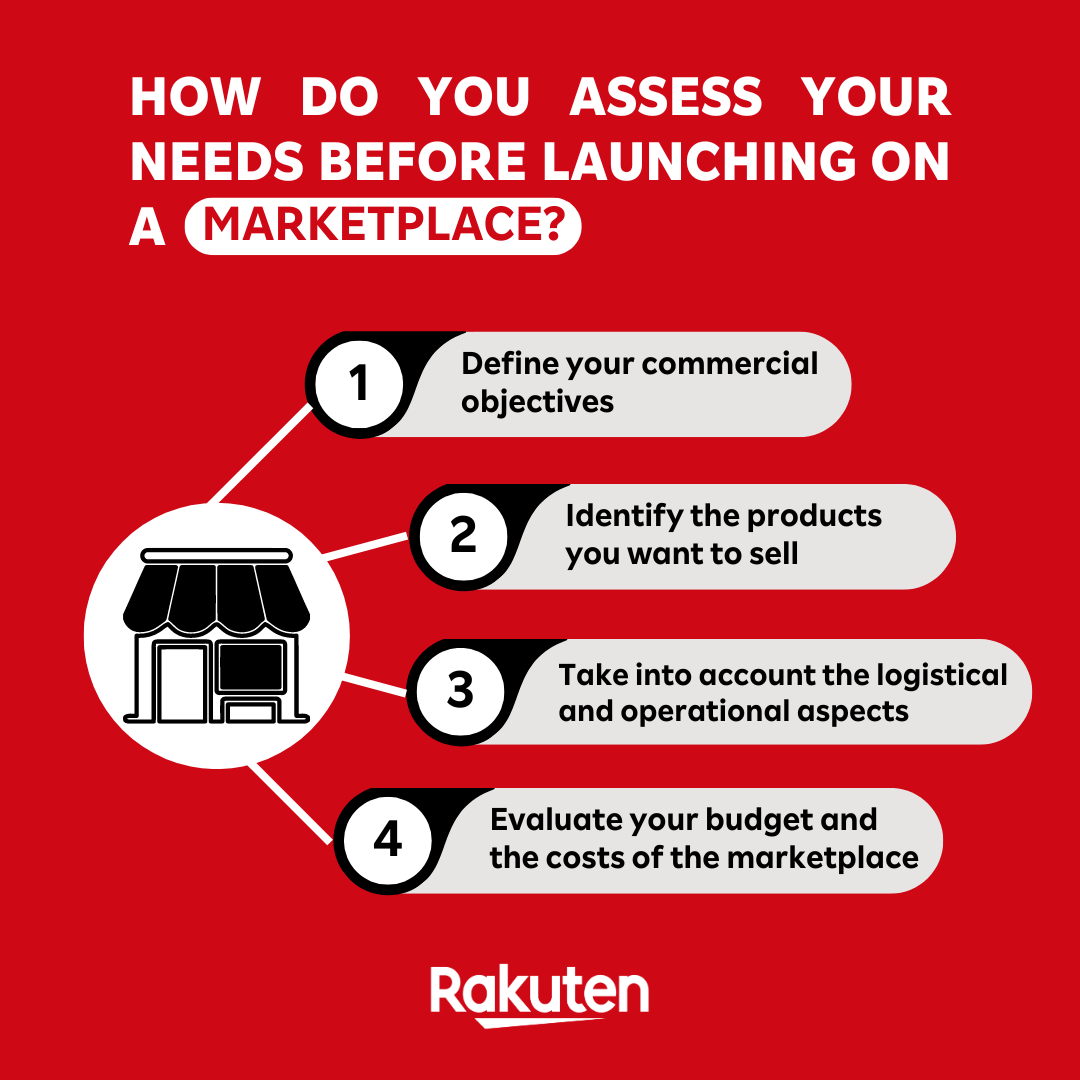
Choosing a marketplace: criteria to consider
To make sure you select the platform best suited to your needs, we present 5 key criteria to consider:
1/ Choose a marketplace that is close to its sellers
The platform's proximity and commitment to its sellers is a very important point. You'll benefit from better support, more effective communication and sales strategies tailored to your business.
For example, Rakuten has a team of e-commerce consultants, specialised by activity. These consultants are dedicated to supporting sellers in their sales experience and optimising their performance on the marketplace.
2/ Choose a marketplace that is 100% marketplace
A marketplace that doesn't sell its own products and therefore doesn't compete with its sellers is a real criterion to consider.
By opting for a marketplace that is 100% marketplace, you ensure that sellers are promoted fairly and that competition is fair.
With no products of its own, Rakuten France's sole objective is to help sellers grow. They are at the heart of the platform.
3/ Choose a marketplace that offers an e-commerce logistics solution
By using a logistics service provider, you save 25% of your time, allowing you to devote more time to your core business.
What's more, you can offer your customers a faster, more efficient delivery experience.
Orders will be processed and shipped directly from the marketplace's warehouses, which can help improve customer satisfaction.
For example, on Rakuten, good customer satisfaction gives you a good Merchant Quality Score (MQS) and makes you more visible on the marketplace.
4/ Marketplace tools and functionalities
Sellers need to consider the features available on the platform, such as inventory management, order processing, and invoicing tools. They should also evaluate the marketing features to promote sellers' products. Considering these features can determine whether they match your business needs, and whether they are sufficient to meet your business objectives. It's also important to consider the ease of use and ergonomics of these tools to optimize your time and resources.
5/ Promotional actions organized by the marketplace
Some marketplaces offer exclusive promotional offers to attract customers to your store. These offers can take a variety of forms, such as shipping discounts, coupon codes, product highlights, and so on. These actions can help increase traffic and sales to your online store, as well as building loyalty among existing customers.
For example, on Rakuten, every first Wednesday of every month, there are "Mega Peaks" where every buyer can benefit from up to 20% cashback, financed by Rakuten.
Rakuten also has a cashback service, Club R, which helps build buyer loyalty.
Join the marketplace that supports the digitalization of retailers
At Rakuten, you can develop your ecommerce without a website and without any risk. We offer a free starter pack, so you're only charged on your sales.
Self-Service in E-commerce: A Powerful Asset for Boosting Customer Relationships
94% of French people want to solve their own problems (source: Yext study, 2023). Today's e-buyers want to find accessible answers in just a few clicks, whatever the time of day or day. Traditional customer services are hardly capable of such responsiveness, but fortunately there is a solution: self-service. Find out in this article about the benefits of self-service tools, and how to set them up easily.
What is self-service?
Self-service refers to all the tools that enable your customers to find precise and immediate answers to their questions themselves . Self-care complements your customer service, giving it greater responsiveness and autonomy.
What are the advantages of self-service?
For your customers, an immediate response at any time
It's Saturday night, 10pm. One of your customers is trying to place an order on your e-commerce site. Unfortunately, his credit card is not recognized. Confused, he tries to find a solution, but it's impossible for him to reach your customer service department at this hour. The customer leaves his browser and abandons his shopping cart in frustration.
This situation could have been avoided with a self-service solution. By enabling your customers to find the answer to their questions at any time, you limit their frustration. In fact, 39% of customers consider it a priority to get an answer the first time they call (source: Qualimétrie, 2022).
Even if this response has to be supplemented by customer service support, the user at least has a way forward.
For your teams, time saved for other tasks
Self-service also relieves your teams of generic, repetitive questions. "How do I return an order?", "My card is not recognized" - these problems often lead to the same answer, wasting precious time.
The time your customer service department saves on these questions can be reinvested in dealing with more specific problems.
And as a salesperson, you know it: every time you save on ancillary tasks, you can focus on your core business: selling.
How do you implement a self-service solution?
There areseveral options for implementing a self-service solution:
Set up a FAQ
A Frequently Asked Question, or FAQ, is a section of your e-commerce site (or your e-shop on the marketplace of your choice) dedicated to recurring questions.
Here are a few points to bear in mind when setting up an effective FAQ:
- Easy access : include links to this FAQ on every page of your site.
- Short, pertinent answers: give the key to the problem in a few words. If your customers want to dig deeper into certain questions, you can always include a link to a more detailed page.
- Exhaustiveness: make sure you cover all your customers' recurring questions.
Create a customer forum
This more interactive solution enables your customers to ask their questions directly on your site. Other users can then respond and share their own experiences. When your customer service department is available, it can then take over and provide more precise answers.
The customer forum solution has the advantage of interactivity. However, it requires customers who are ready to interact on the forum. What's more, it requires technical resources for implementation and a team dedicated to forum moderation (to sort through posts, respond to comments, etc.). So it's not the best solution if you're working with a small team.
Implementing a chatbot
A chatbot is a virtual assistant that helps your customers find their answers. There are three types of chatbot:
- Simple chatbots: they operate according to predefined scripts, often based on keywords or suggested queries. These are the simplest and least expensive to set up, but lack flexibility.
- Intelligent chatbots: these are based on machine learning and natural language processing. They are capable of analyzing the intention behind messages and providing a highly personalized response to the interlocutor.
- Hybrid chatbots: these combine the functionalities of simple and hybrid chatbots. They first use AI to identify the query, before redirecting the interlocutor to a script or human customer service.
At Rakuten, our Yuki customer chatbot combines these three approaches and is evolving every day. Today, it relies on Large Language Models (LLM) to offer increasingly personalized responses to customers. The ultimate goal? To turn it into a complete virtual assistant, capable of complementing our human approach to provide the best answers, 7 days a week, 24 hours a day.
Self-service, a complementary approach to human relations
Self-care tools are an invaluable asset in your e-commerce strategy, but they must not replace human customer service. At Rakuten, we're convinced that the human relationship must remain at the heart of interactions between customer and salesperson.
That's why our marketplace offers complete, dedicated customer service support for our sellers. We provide them with specific tools for their online store. And as a seller on Rakuten, you benefit from significant support via our internal messaging system, to help you manage and optimize your after-sales service.
Your customers need to feel listened to, unique. They need to understand that their satisfaction is your team's priority. So always keep in mind the balance between human support and self-care.
For example, you can integrate into your FAQ or chatbot the possibility of making an appointment with a member of your customer service team.
Rakuten Worldfirst partnership: Why a multi-currency account is the answer to your international payments
Selling on marketplaces sometimes means you can be dealing with buyers from different countries and getting paid in various currencies. When you’re juggling different overseas bank accounts, worrying about exchange rates and facing delays in accessing your funds, this can affect your business operations.
What if there was a simpler, more efficient way to handle it all?
The power of a multi-currency account
Imagine having a single account where you can receive, hold and manage payments in multiple currencies, without having to constantly convert funds or pay unnecessary fees. Whether you’re paid in euros, dollars or yen, you can keep your funds in the currency you receive them in, giving you flexibility and control over when to convert or withdraw your money.
This kind of multi-currency management provides a real advantage as a seller when it comes to improving your cash flow, reducing exchange rate risk and making easy, fast and secure payments to suppliers around the world.
The World Account, your all-in-one solution
That’s exactly what the World Account offers. It’s designed to meet the needs of marketplace sellers looking to expand globally. With a World Account, you can:
Open 20+ local currency accounts
Collect your earnings from your Ratuken sales in local currencies without worrying about conversion fees. Your money goes straight into your account, and you can see all your earnings in different currencies in one central dashboard. Plus, it takes just minutes to open an account in the currency you need, no overseas address needed.
Hold and convert funds when it suits you
Instead of converting your earnings immediately, you can hold them in their original currency and wait until the exchange rate is in your favour to either convert them between your currency accounts or withdraw them home.
Manage multiple currencies in one place
No more juggling different bank accounts in different countries. The World Account allows you to receive and hold multiple currencies and use your balance to pay suppliers globally or make transfers.
Faster payments, better cash flow
One of the biggest benefits of the World Account is how quickly you can access your marketplace earnings. Your local currency accounts rely on domestic networks, not international ones, meaning payments take minutes or hours, rather than days, to arrive.
In terms of business operations, this allows you to reinvest in your business more quickly, pay suppliers on time or simply have the funds accessible when you need them.
Save on fees and exchange rates
Traditional banks often charge high fees for international payments, not to mention receiving fees and a currency conversion margin. Often, these fees aren’t transparent so you may not even be aware how much you’re being charged. With a World Account, you not only save on these charges, but you also benefit from competitive exchange rates. This means you keep more of your hard-earned profits and avoid losing money to unnecessary fees.
It's free to receive payments with a World Account, and all fees are clearly stated so you know exactly what you’re paying when you’re transferring funds to suppliers.
Financial stability and flexibility
A multi-currency account can also help protect your business from sudden changes in exchange rate. When you can hold funds in different currencies, you won’t need to worry about losing money when currencies fluctuate, giving you more stability and control over your profits.
Additionally, being able to use local currencies in key markets can give you an advantage over competitors. Customers appreciate the option to pay in their own currency, while you can strengthen relationships with suppliers by paying them in their preferred currency.
Ultimately, a multi-currency account empowers businesses to operate more efficiently on a global scale and stay competitive in the marketplace.
Ratuken has partnered with WorldFirst to offer Ratuken sellers a €49 monthly credit towards the Ratuken Expert Package for up to six months, when you open a World Account. Find out more here.
What is omnichannel e-commerce?
Electronic commerce, or e-commerce, has revolutionized the way people buy and sell products and services online.
However, with the rapid expansion of e-commerce, consumers now expect a seamless and diverse shopping experience, regardless of the channels they use. This is where omnichannel comes into play
What is omnichannel e-commerce?
Omnichannel is a sales strategy that enables consumers to navigate easily between different sales channels.
Customers can move from one channel to another without losing their purchase history or their shopping cart. For example, a customer can start filling their basket on a website, continue on a mobile app, and finalize their purchase in a physical store without having to start the purchasing process all over again.
This enables companies to offer a consistent and seamless shopping experience, which can improve customer satisfaction and loyalty, as well as sales. In this diverse landscape, the crucial question arises: marketplace or e-commerce?
Omnichannel vs. multichannel: what are the differences?
Omnichannel and multichannel are two online sales strategies that are often confused, but which have major differences.
Multichannel, on the other hand, involves the use of several sales channels. However, these channels are independent of one another. This can lead to problems of consistency and harmonization, both in communication and in the buying experience.
The different omnichannel sales channels
Here are the most important ones:
Online store:
The online store is one of the most important sales channels in an omnichannel strategy. It enables customers to access the company’s products and services at any time, from any location, without having to physically visit a store.
To be effective, an online store must be intuitive, easy to navigate and compatible with the different types of devices used by customers, such as smartphones, tablets and computers.
Marketplace:
A marketplace is a website that brings buyers and sellers together.
The advantages for companies selling on these platforms are numerous: increased visibility to a wider audience, payment and delivery infrastructure already in place, simplified transaction management, reduced marketing and advertising costs, etc. But how do you choose a marketplace?
Social networks:
Social networks, such as Facebook, Instagram, Twitter and Pinterest, enable companies to sell their products directly from their social media pages or accounts.
Using this sales channel allows companies to strengthen their online presence and interact directly with customers. It also offers a variety of sales tools, including buy buttons and integrated payment functionalities, which make the transaction easier for customers.
Mobile applications:
These enable companies to offer more personalized and mobile online shopping experiences. Customers can purchase products using their smartphone or tablet, which can enhance the shopping experience by offering localization and personalization features.
However, creating a mobile app can be costly and time-consuming, especially for small businesses.
Physical stores:
Physical stores are a traditional sales channel that can also play an important role in an omnichannel strategy. Although more and more consumers prefer to shop online, physical stores continue to offer a unique shopping experience that customers can’t find online.
Indeed, some companies have a network of physical stores and offer their customers the option of ordering online and collecting their order in-store (click and collect). This allows customers to benefit from the convenience of e-commerce while enjoying the in-store experience and personalized advice of sales staff.
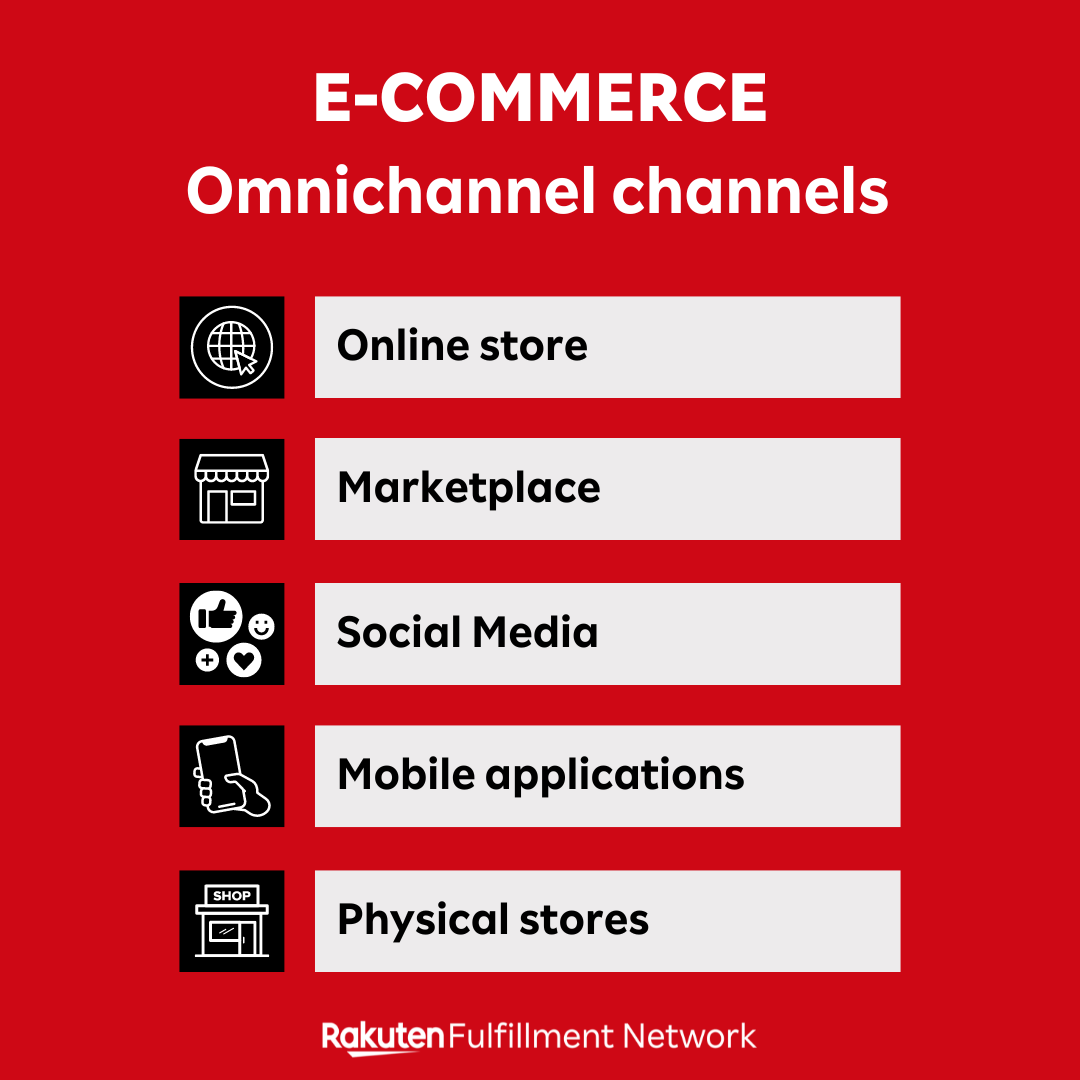
The importance of omnichannel
1/ Meeting customer expectations
Today’s customers have high expectations when it comes to the shopping experience. They want a consistent shopping experience across all sales channels, with accurate product information and flexible delivery and return options. Omnichannelity enables companies to meet these expectations and offer a seamless shopping experience, no matter how the customer chooses to shop.
2/ Increase sales
Omnichannelity enables companies to increase sales by offering customers more diversified purchasing options with a cashback system. Customers can buy online and collect in-store, buy in-store and have it delivered to their door, or buy online and return in-store. This enables companies to reach a wider audience and maximize sales opportunities.
3/ Greater visibility
By being present on several sales channels, companies can improve their online visibility. Marketplaces, social networks and mobile applications are platforms where consumers spend a lot of time, and being present on these channels can help companies reach new customers.
4/ Improve customer loyalty
Omnichannel can improve customer loyalty by offering a more personalized shopping experience. Companies can collect data on customers’ buying habits and preferences across all sales channels, enabling them to provide personalized offers and recommendations. This can help build customer loyalty and encourage them to return for further purchases.
5/ Inventory management optimization
By connecting their sales channels, companies can gain an overview of their inventory and better manage their stocks. This prevents stock-outs and optimizes inventory management for each sales channel.

The challenges of omnichannel
Channel integration:
Integrating different sales channels can be a major challenge. You need to be able to track inventory in real time, synchronize customer data and guarantee a consistent experience across all channels.
Implementation costs:
Setting up an omnichannel system can be costly, both in terms of IT development and investment in the various sales channels.
Logistical complexity:
Processing orders from different channels can be complex, especially when it comes to delivering products efficiently and cost-effectively.
Changing customer expectations:
Customer expectations oftheshopping experience continue to evolve, which means that companies must be able to adapt quickly to these changes to remain competitive.
How to implement an omnichannel strategy?
Implementing an omnichannel strategy may seem complex, but it can be achieved by following several practical steps:
1/ Analyze your customers' needs:
The first step is to understand your customers' expectations and buying behaviors. You can use surveys, sales data and other information to gain an overview of your customers' preferred sales channels.
2/ Identify relevant channels:
Once you understand your customers' needs, you can determine which channels are most relevant to your business. This can include online channels (website, marketplaces, social networks) and offline channels (physical stores, events).
3/ Set up performance tracking:
It's important to set up a performance tracking system to measure the effectiveness of your omnichannel strategy. This can include metrics such as conversion rates, cart abandonment rates, delivery times, customer satisfaction levels, etc. Performance tracking will let you know what's working well and what needs to be improved for an even more effective omnichannel strategy.
4/ Join the marketplace that facilitates the development of your omnichannel strategy
At Rakuten, you can have different sales channels, brought together on the same platform.
In fact, you can create an E-Shop on Rakuten, a space entirely dedicated to your offers, enabling your visitors to discover your brand universe; like a merchant site, but at a lower cost.
We also have a mobile application and social networks where buyers can find all our sellers' products.
And finally, if you have a physical store, we offer customers click & collect.
*Source AT: Internet
How to avoid abandoned carts in e-commerce?
Abandoned carts are a frequent problem in e-commerce, depriving you of part of your sales. Find out how to reduce them with our tips.
What are abandoned carts?
This is it. Your acquisition strategy is well under way. One of your future customers arrives on your e-commerce site or the marketplace of your choice. He discovers your products, browses the product sheets you've carefully created. Finally, they add an item to their shopping cart, get ready to finalize their order and... leave the site. End of story.
You've just experienced an abandoned cart, when one of your buyers leaves the site before finalizing his order. Abandoned carts can occur at several stages of the purchasing process:
- Even before accessing the shopping cart, when the user has added a product to the cart but leaves the site;
- When choosing delivery options, because the costs are too high for the customer or the delivery methods unsuitable;
- At checkout, because the customer wishes to use a specific payment method or compare prices again.
Abandoned cart = wasted efforts
Abandoned carts are a direct loss for your brand. You've gone to great lengths to get users to add your products to their shopping baskets: marketing and acquisition strategy, pricing strategy, shopping funnel optimization... It's a shame if this investment is lost at the last stage of your customer journey.
Rest assured, abandoned carts are inevitable in e-commerce. E-buyers are constantly stimulated, and these distractions can divert them from their purchases.
Fortunately, you can limit abandonment. There are 8 tips you can put in place today:
8 tips to reduce abandoned carts in e-commerce
A functional, responsive site
If you sell on a marketplace, this should not be a problem. Your marketplace takes care of the technical side of things, ensuring that your site is fast and functional. At Rakuten, for example, our dedicated teams make sure that the site runs smoothly, and regularly add new features to constantly improve our customers' experience.
If, on the other hand, you have your own e-commerce site, you need to ensure its quality. Check the following points in particular:
- Page-loading speed: if your site takes too long to load, your customers may be put off. To speed up loading, consider reducing the size of images and optimizing the source code of your pages.
- Visual clarity: overloading your web pages and product sheets with information is a bad idea. Your customers need to understand quickly where to click to perform their actions. Add margins, prioritize information and pay attention to the overall aesthetics of your pages.
- Up-to-date visuals: make sure your graphics are up to date and consistent with your brand.
- Responsive website: 62% of online purchases are made from a cell phone, and 47% of e-buyers use different screen formats (source: Fevad 2024). Your e-commerce site must therefore be optimized for mobile phones. Think about adjusting font sizes, margins, etc.
A fast, intuitive customer journey
The fluidity of your purchasing path is essential for your customers to finalize their order, as well as being a decisive factor in your customer satisfaction. Add guidance to your pages, maintain visual consistency and, above all, prioritize information. Every step of the journey should have the same objective: to help customers complete their order.
A fast customer journey also maximizes your chances of retaining customers to the end. Count the number of steps between the moment a user selects a product and the moment the order is finalized. Then analyze each of these steps and eliminate any unnecessary ones. For example, do your customers really need to create an account to order?
Then analyze the distractions on each page or step, and try to reduce them. For example, are recommendations for additional items always relevant, or do they tend to distract users from their purchase?
Attractive, transparent delivery costs
Nearly 70% of customers abandon their shopping baskets because delivery charges are too high (source: Baymard Institute 2023). To keep as many buyers as possible on track, you need to offer attractive delivery charges.
To calculate your delivery costs, keep in mind your various costs (packaging, shipping, returns, etc.) and consider your margins. The aim is not to lose profitability. Analyzing the charges offered by your competitors is also a good way of positioning yourself.
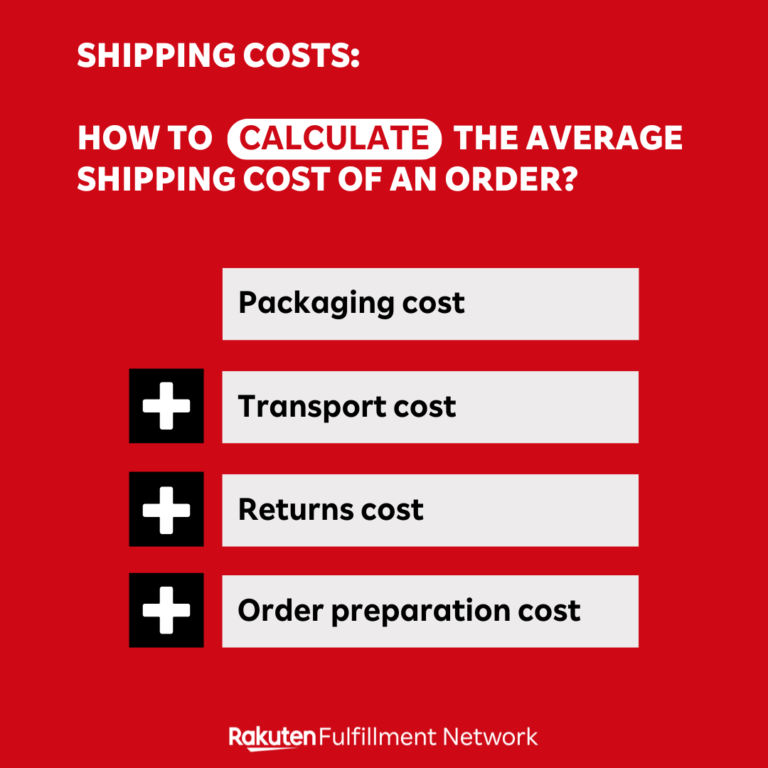
If your margins allow it, you can also opt for free delivery. This method has the advantage of increasing your customers' average basket and helping to build loyalty. On the other hand, it reduces your sales margins and is therefore not suitable for all situations.
Whatever delivery charges you choose, you owe it to your customers to be transparent. Offer simple, easy-to-understand grids, for example, by grouping items into weight categories.
Choice of delivery method
For 88% of e-buyers, e-commerce is synonymous with saving time (Fevad 2024). Your customers need to be able to receive their product as close to them as possible, and at the right time to suit their needs.
While home delivery remains the preferred mode of delivery for 77% of e-buyers (Fevad 2024), 71% also opt for collection from a relay point and 25% for click and collect.
If you can, consider offering your customers several different delivery solutions. You should also make sure that your advertised delivery times are not too long. Consumers are more likely to validate their basket if they receive their parcel the next day than if they have to wait a week.
Several payment methods
Flexible payment options are another important parameter to ensure that your customers complete their order. In fact, 37% of e-buyers in 2023 used an electronic payment solution, 27% an instant transfer, 29% a gift card or gift voucher and 28% other solutions other than bank cards (Fevad 2024).
By offering your customers a variety of payment methods, you enable them to choose the solution that best suits their needs, and avoid frustration (for example, when the payment exceeds their card payment limit).
Good customer follow-ups
In most cases, an abandoned cart is not a definitive defeat. You can follow up with your customers to try to bring them back to their shopping baskets. There are several ways to do this:
- Directly on your site, for example via pop-ups that appear on other pages if the user has forgotten a product in their basket for some time. Not very intrusive, but only works if the customer is still on the site.
- E-mail reminders: this solution requires you to have previously collected your customers' e-mail addresses (with their consent). It's fairly non-intrusive, but your send and open rates may remain fairly low.
- SMS reminders : an intrusive method, but with fairly good open rates. Here again, the numbers must have been collected with the customer's consent (when they create an account on your site, for example).
- Call-backs : only for products with high added value, and which may take a long time to decide to buy. To be avoided as a general rule, as they are very intrusive.
The most important thing is to get the timing and timing of your follow-ups right. Don't be too insistent, but don't let too much time go by before calling the customer back, or you risk losing the sale for good.
Good customer feedback management
The reviews that previous buyers have left on your products are an invaluable source of information for your future customers. A negative review can easily scare off a potential buyer.
Unfortunately, you have no control over the publication of these reviews. However, you can limit their negative impact in two ways:
- By responding to reviews, especially negativeones: dispel any doubts about negative experiences by offering a professional response and demonstrating your willingness to resolve the problem.
- By encouraging your satisfied customers to leave a review: a few negative comments are less problematic if they are accompanied by comments praising your products.
A satisfactory returns policy
Before finalizing their purchase, your customers want to be sure that the item will suit them, which they can't always verify before receipt. Similarly, delivery errors can occur. So it's vital to offer your customers a good returns policy. 54% of buyers, for example, say that free returns and exchanges are the second most important influence in their decision to buy from a brand (source: WalkerSands study). 58% of potential buyers also want to be able to return goods easily, with clear, precise instructions on the website and/or in their parcel.
Think about it this way: a consumer who buys one of your items, isn't satisfied with it, and can't easily return it, will probably never buy from you again. By making it easy for them to return the item, you turn a negative experience into a loyalty-building opportunity. Offering a simple, no-cost returns process shows your customers that their satisfaction is your priority, which reinforces their trust in your brand.
Reverse logistics (or returns management) is therefore an essential part of your e-commerce strategy, and one that can seem complex to manage at first glance. Fortunately, turnkey solutions such as Rakuten Fulfillment Network enable you to outsource these tasks so you can concentrate on what really matters: selling.
Customer Satisfaction: How to Maximize It in E-Commerce
Customer satisfaction measures a consumer's satisfaction with a product, a service or, in a broader sense, a shopping experience. This metric is crucial for e-commerce. Find out why this is the case and how you can maximize it!
Why should you pay attention to customer satisfaction?
Customer satisfaction as a performance indicator
Customer satisfaction is a key performance indicator (KPI) in e-commerce. It directly reflects the quality of your products, but also of your entire interaction with customers (purchase path, customer service, etc.).
Measuring customer satisfaction allows you to understand your current performance or that of the near past, but also to anticipate it. This indicator can provide you with information about your customers' future actions: purchase intentions, word-of-mouth, etc
It is also an excellent way to differentiate yourself from the competition.
Maximize customer satisfaction to retain customers
If you also provide a satisfying user experience, you encourage your customers to buy from you again. A strategy that pays off for several reasons:
- The cost of retaining a customer to your business is estimated to be five times lower than the cost of acquiring the same customer.
- Your loyal customers are more likely to increase their average shopping cart. At Rakuten, our loyalty program members spend on average 40% more than non-members.
- A shopper who is already familiar with your products and shopping journey is more likely to complete their order, reducing cart abandonment.
Even if you sell products where the average purchase frequency is lower (e.g. large household appliances), you should maximize your customer satisfaction. If your customers are happy with their experience, they can spread positive word of mouth and attract new buyers.
How can you measure customer satisfaction in e-commerce?
Measure customer satisfaction with the CSAT
The CSAT, an acronym for Customer SATisfaction, is a score calculated from questionnaires sent to your customers. These are usually questionnaires with only one question and a limited range of answers. An example of a questionnaire could be:
"Are you satisfied with your purchase?" where the possible answers include the following:
- " Yes " or " No "
- A rating scale (e.g. from 1 to 5 or from 0 to 10)
- A satisfaction scale ("Very satisfied", "Satisfied", "Neutral", "Not satisfied", "Not at all satisfied").
To calculate the CSAT score, the number of positive responses is then compared with the total number of responses:
CSAT = (number of positive responses/number of total responses) x 100
The advantage of this indicator is its simplicity. With just one question, you increase the likelihood that your customers will answer your questionnaire. It is also easy to apply to different types of products.
On the other hand, the CSAT lacks detail : you know the percentage of dissatisfied customers, but you don't know why. Fortunately, there are other tools that can provide you with this information.
Measuring customer satisfaction with the Net Promotor Score
The Net Promotor Score measures the likelihood that a customer will recommend your products to others. It is based on a score from 0 (not at all likely) to 10 (very likely) that the customer gives in response to the question "Would you recommend our product to a relative?"
A distinction is then made between three categories:
- Critics (score between 0 and 6): dissatisfied customers who could damage your image
- Passives (score 7 or 8): satisfied but unenthusiastic customers
- Promoters (score 9 or 10): very satisfied and loyal customers who are involved in the development of your company
Calculation of the Net Promotor Score
The NPS score is then calculated by subtracting the percentage of detractors from the percentage of promoters. Example:
Out of 18 customers surveyed, 3 gave a score between 0 and 6, 10 gave a score of 7 or 8 and 5 gave a score of 9 or 10, so there are :
- 3/18 = 17% Critics ;
- 10/18 = 55% passives ;
- 5/18 = 28% supporters.
Your NPS is then 28 - 17 = 11
Interpretation of the Net Promotor Score
An NPS of over 0 is considered a correct promoter score. The number of customers who are willing to recommend your products to others exceeds the number of customers who spread negative word of mouth. However, be sure to take these critics into account, as they can severely damage your reputation.
An NPS of over 50 is a very good score, indicating a strong bond with your brand and a high level of loyalty. You are on the right track!
To obtain a more representative result, you can add further data to your calculation of the Net Promotor Score. Do you count more critics among certain groups of buyers? Are there an unusually high number of promoters for certain products? The possibilities are endless.
Measure customer satisfaction based on user reviews
The reviews that your customers leave on your website are a valuable source of information. Take the time to analyze these opinions and understand possible points of friction that emerge from the comments. Pay particular attention to recurring comments, as they often indicate an underlying problem.
However, be careful not to rely on this indicator alone. The majority are often silent and will not leave a review even if their experience is negative. Conversely, some comments written in the heat of the moment may exaggerate the actual problems. So be sure to maintain a critical approach and always supplement your analysis with other indicators.
Also remember to respond to your customer reviews! They are important signals that are sent to your other customers. 58% of French people and 70% of 15-24 year olds say they consult a customer review before making a purchase (source: Fevad 2024). A negative comment that remains unanswered is a bad signal for your potential buyers.
How to maximize customer satisfaction in e-commerce?
To guarantee your customers the best experience, you should pay attention to a few key points:
High quality products at the right price
This is the first parameter you should consider. Make sure you offer quality products with a good value proposition. Your products must meet the needs of your customers. To do this, it is necessary to address the right target groups. Define your target customers and develop an effective pricing strategy that will help you stand out from the crowd.
Pay attention to all aspects of your products (ease of use, durability, packaging...), nothing should be left to chance.
An intuitive customer journey
Nothing is more frustrating for a shopper than having to go through many tedious steps before they can finalize their order. A smooth customer journey is a key element to your success in e-commerce.
Whether you're selling on e-commerce or through a marketplace, make sure to make the purchase path as clear as possible. Add visual cues, reduce the number of redundant steps.
The quality of your product sheets is particularly important for this. Is all product information accurate and up to date? Are the call-to-actions easily recognizable? Does your index card contain customer reviews?
Efficient deliveries
Once your buyers have ordered their product, they can hardly wait to receive it. Excessively long delivery times, incorrect deliveries or lost parcels have a major impact on your customers' experience. With a fast and efficient logistics service, you can keep this friction to a minimum.
Also pay attention to your shipping costs ! 62% of e-shoppers abandon their order if the shipping costs are too high (source: Sendcloud study, 2023). So make sure that you offer reasonable costs that still allow you a sufficient profit margin.
Good customer service
Even with the best store and the best delivery service, mistakes happen and your customers may encounter problems. 5 out of 10 French shoppers contact customer service if they have a question or an update on their order or delivery (source: Essendex, 2023). So you need to make sure you have effective customer service to stand out from the crowd.
Pay particular attention to the following points:
- Responsiveness: this is the priority for 39% of e-commerce shoppers (source: Qualimetrie, 2022). Your support must respond quickly and accurately to your customers' requests.
- Personalization: No one wants to be seen as a mere number. Your customers need to feel listened to, recognized and, above all, unique! Make sure you always mention their name and offer them personalized services in return. Retrieving accurate data about your customers (purchase history, preferences, etc.) allows you to respond precisely to their needs.
- Customer autonomy tools : Most of the time, your customers will want to find the answers to their problems themselves. Make sure you offer a comprehensive FAQ (Frequently Asked Questions) listing recurring requests. Your customers will save time and your teams can focus on more complex problems. A win-win situation for everyone!
Apart from solving problems, your customer service is the direct link to your customers. It is therefore the reflection of your company to them. Returns management, collecting customer opinions, creating exclusive offers and promotions... each of these steps can help you stand out from the crowd and increase your customer satisfaction!
Rakuten France, a platform at the service of customer satisfaction
As you will have understood, customer satisfaction in e-commerce must be at the top of your list of priorities. At Rakuten, this is one of our core commitments and we strive every day to improve shoppers' experiences. Learn how Rakuten can help you maximize your customer satisfaction:
An intuitive and well-rehearsed shopping journey
Rakuten offers its buyers a seamless shopping journey. On our Marketplace, each product card contains all of our sellers' listings for a specific item. An efficient way for a buyer to compare prices without having to leave the product card. The customer can then add the items of their choice to their shopping cart and submit their order with just a few clicks.
Our platform benefits from the many years of expertise of our teams. What is our goal? To deliver an optimal user experience. And our 13 million loyal shoppers have understood that.
As a seller, you have the opportunity to create your own e-shop on our platform to keep control of your brand image and personalize your customer journey.
Support from your customer service
Rakuten offers its sellers comprehensive and dedicated customer service support. If you are a seller on our platform, we provide you with a range of dedicatedtools for your online store.
You also receive first-class support thanks to the internal messaging service, which helps you manage and optimize your customer service.
Rakuten Fulfillment Network, for efficient omnichannel logistics
Finally, our Rakuten Fulfillment Network service allows e-commerce merchants to outsource all their logistics tasks: packing orders, managing returns, monitoring stock levels... we take care of everything!
With this service, you benefit from :
- Lower logistics costs thanks to our fixed price. Our customers save an average of 25% on their logistics costs;
- A flexible service for customized logistics;
- A centralized area to manage all your logistics with just a few clicks;
- A high-quality service for your customers through fast deliveries and efficient returns management. 99.8% of orders received before 2pm are delivered within 24 hours.
Barcodes: Why They Matter in E-Commerce
Whether you're buying or selling a book, a telephone case or a vacuum cleaner... All these products have one thing in common: the presence of a barcode. These symbols are made up of lines, spaces, characters, and numbers. Ubiquitous in our daily lives, they are also indispensable in e-commerce, particularly for selling your products online on a marketplace like Rakuten.
In this article, we explore the crucial importance of barcodes, how they work and how to use them. Do you want to sell your products online? Then this article is for you!
What is a barcode?
Barcode definition
Bar codes are printed on product packaging. It consists of thin parallel bars that allow data to be identified and displayed using an optical scanner. This data is used for information and marketing purposes, to track the traceability of a product throughout the supply chain (procurement, inventory management, in-store or online purchase tracking, etc.).
The code is materialized by a series of 13 digits and is known as the Global Trade Item Number (GTIN). In other words, this code is a product's identity card. Thanks to this unique codification, all product information can be identified: composition, country of manufacture, manufacturer's identity..
For the record, the barcode turns 70 in 2022! The first patent was filed in 1952 by two American engineers seeking to automate the registration of manufacturers' products. Twenty years later, the technology was developed for its first deployment in supermarkets. And today, the barcode is also indispensable in e-commerce and virtual marketplaces like Rakuten. But you still need to know how it works.
How a barcode works
Let's start by deciphering the composition of a GTIN/EAN barcode (European Article Numbering): this is the most common type of barcode, used for products sold internationally.
The first digits generally indicate the product's country of manufacture (or, in some cases, the country where the company's head office is located). The 3rd to 7th digits indicate the manufacturer number. The 8th to 12th digits indicate the item number. Then the last digit represents the check digit confirming the barcode.
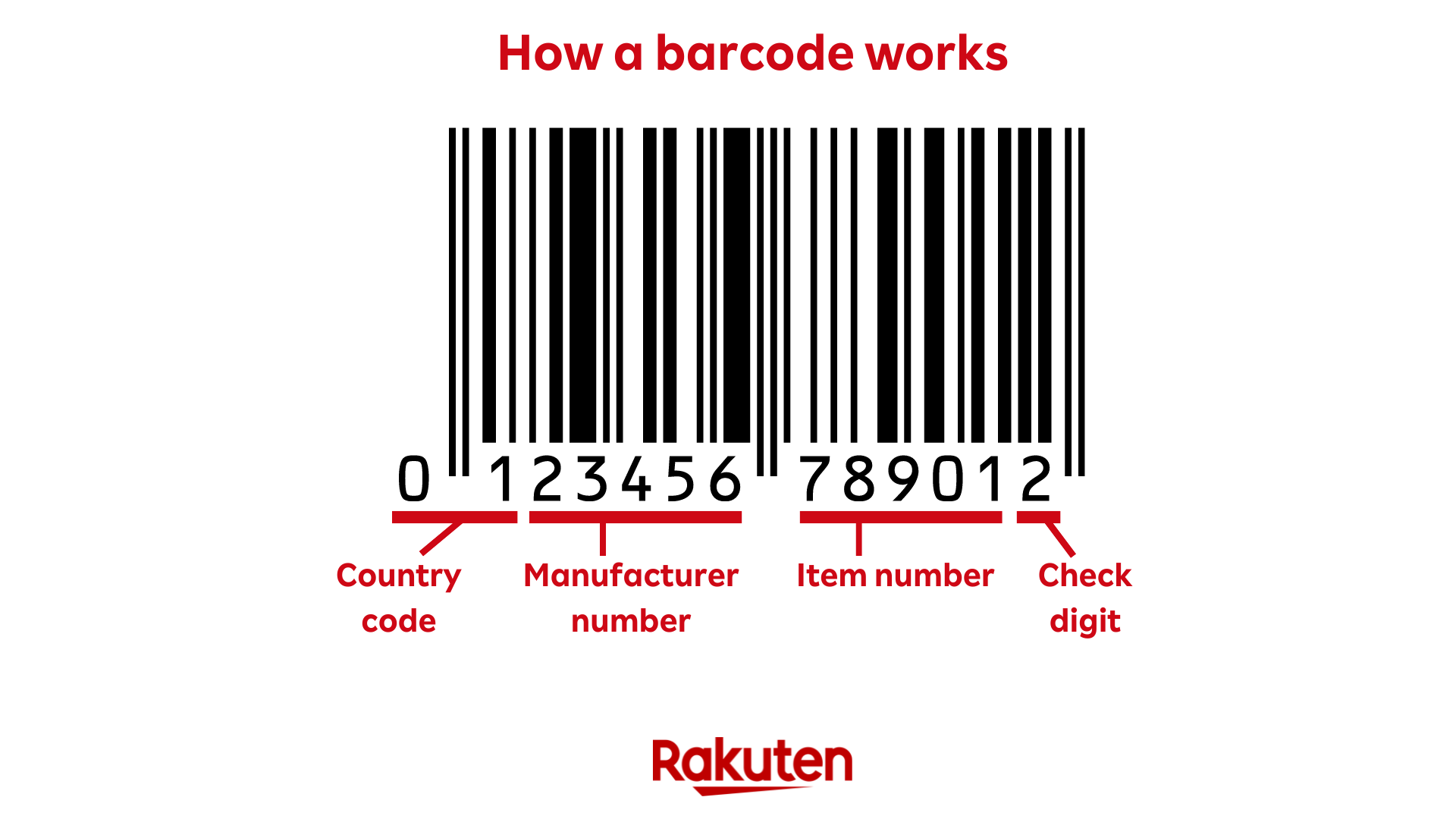
Among the best-known barcodes are :
- UPC barcodes: mainly used in North America.
- 128 barcodes: used for logistics and internal tracking, they include silence sections, a start character, an FNC1 function code, a control character and an end character.
- 39 barcodes: used for marking medicines and certain industrial products. These codes can be up to 43 characters long, with symbols at the beginning and end.
Scanners read and interpret these number sequences, to track the traceability of an item. But do you know why this data is important, especially for e-tailers?
The importance of barcodes in e-commerce
Here are the advantages of barcodes:
- Precise, rapid stock tracking : thanks to these symbols on products, you can improve your inventory management. This helps reduce human error and improve internal efficiency.
- Better management of shipments: by facilitating product traceability (from the warehouse to the end consumer), barcodes enable better management of returns or complaints.
- Speeding up the logistics process: using a barcode is particularly useful for limiting data-entry errors and speeding up the sales process (and time-to-market!), especially on a marketplace like Rakuten. Barcodes provide information almost instantaneously, without the need for research. It also makes restocking easier.
- Enhanced compliance: barcodes are a lever in the fight against fraud, as the system prevents embezzlement. E-merchants who buy their products from suppliers can have better control over what they are buying.
- Improved natural referencing: Google considers the GTIN/EAN to be a unique key for verifying product identification. By adding this barcode to the product data sheets on your e-commerce site or marketplace, Google enhances the referencing of your products. Internet users will find them more easily. Practical for boosting your online sales!
- Increased customer loyalty: this barcode system has enabled the development of loyalty cards, initially in physical stores, but now also online. Thanks to barcode data tracking, online stores can keep track of shoppers' preferences, and offer them personalized loyalty operations (such as promotional codes).

Let's find out how to use this coded system to sell your products in the marketplace.
Using barcodes on marketplaces
Would you like to sell your products on a marketplace like Rakuten, targeting 13 million regular buyers? The presence of a barcode on your items is essential. In terms of standards and requirements, marketplaces like Rakuten France require a unique GTIN/EAN barcode for each product. This is a security feature, to guarantee the precise identification of products and verify their authenticity. In this way, we can protect buyers from counterfeit products and guarantee the quality of their purchases.
What's more, the use of barcodes can improve the SEO and visibility of your products on the platform: ideal for increasing sales and boosting your growth!
They can also improve product catalog management, by grouping similar offers from different sellers on the same product sheet. Internet users benefit from a better user experience: they can compare prices and purchase options, before making their decision.
So, are you ready to take action? Here are a few tips for getting started on a marketplace like Rakuten:
Tips to add barcodes on a marketplace
- When creating your product listing, you'll need to enter a product code such as EAN/UPC/ISBN (GTIN), depending on the type of product concerned.
- If your item doesn't have a barcode, it's possible that the database of products available on Rakuten contains an identical item. Use the "Search" function to find it. If you find this item in the results, open the file, check that it's exactly the same product you're selling, then click on "Sell yours". Be sure to comment on any differences with the description in the listing.
- If your barcode is not recognized when you enter it, try entering all the digits without spaces or dashes. For CDs, DVDs and video games, the code is a unique number, often with 13 digits. If there are only 12, add a 0 at the beginning. For books, an ISBN number and an EAN13 code can be found on the back or inside the book. Rakuten is able to recognize both: enter one or the other, without spaces or hyphens.
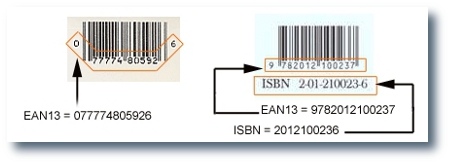
To create product sheets that convert, filling in the barcode is the first step. Now discover the next steps. Here are the 17 criteria for creating high-performance product sheets:
How do I create a barcode?
Step 1: become a GS1 member
To create a barcode for one of your products, you must first become a member of GS1 France. This non-profit organization is responsible for allocating barcodes in France. Once on the GS1 website, fill in the form with your details (business e-mail, company details, etc.).
Depending on your turnover, you'll then have to pay a registration fee to be able to register your barcodes. These fees include:
- An entry fee, paid on registration.
- An annual fee, paid each year. Membership is renewed by tacit agreement. If you no longer wish to use barcodes, you can
The membership fee depends on your company's sales. For example, it is :
- 99 € for annual sales of less than €50,000 (then €99 each year) ;
- 177 for annual sales between €500,000 and €1 million (then €177 each year)
Good news: this fee is fixed, regardless of the number of barcodes generated. Even if your catalog is very extensive, you'll pay the same price for it.
Step 2: Use a barcode generator
Once you've finalized your membership, all that's left to do is generate your barcode. First, choose the type of barcode that best suits your needs. For sales in Europe, the most common format is EAN-13.
Then go to one of the many barcode generators available online. You'll then need to enter a GTIN code created by GS1. You can generate these codes from your customer area on this platform. Once the code has been generated, you can download it and use it on the e-commerce site or marketplace of your choice. And that's it!
Good to know: GS1 France offers its own barcode generator. Handy for retrieving the information you need directly!
Use barcodes to sell on Rakuten
Now you know the definition, operation and use of a barcode in e-commerce or marketplace. A veritable identity card for an item, this type of code is essential for efficient management of your e-shop. Not only does it ensure product traceability and authentication, it also enables you to better manage your product inventory,improve your online natural referencing and optimize the user experience.
On a platform like Rakuten, the presence of a barcode on your items is mandatory. Far from being a constraint, this system is actually beneficial for our 7,000 professional sellers: once the barcode of their products has been entered on their e-shop, they can sell their products to Rakuten's 13 million loyal and regular buyers.
Would you like to increase your sales easily? Join our marketplace today:
